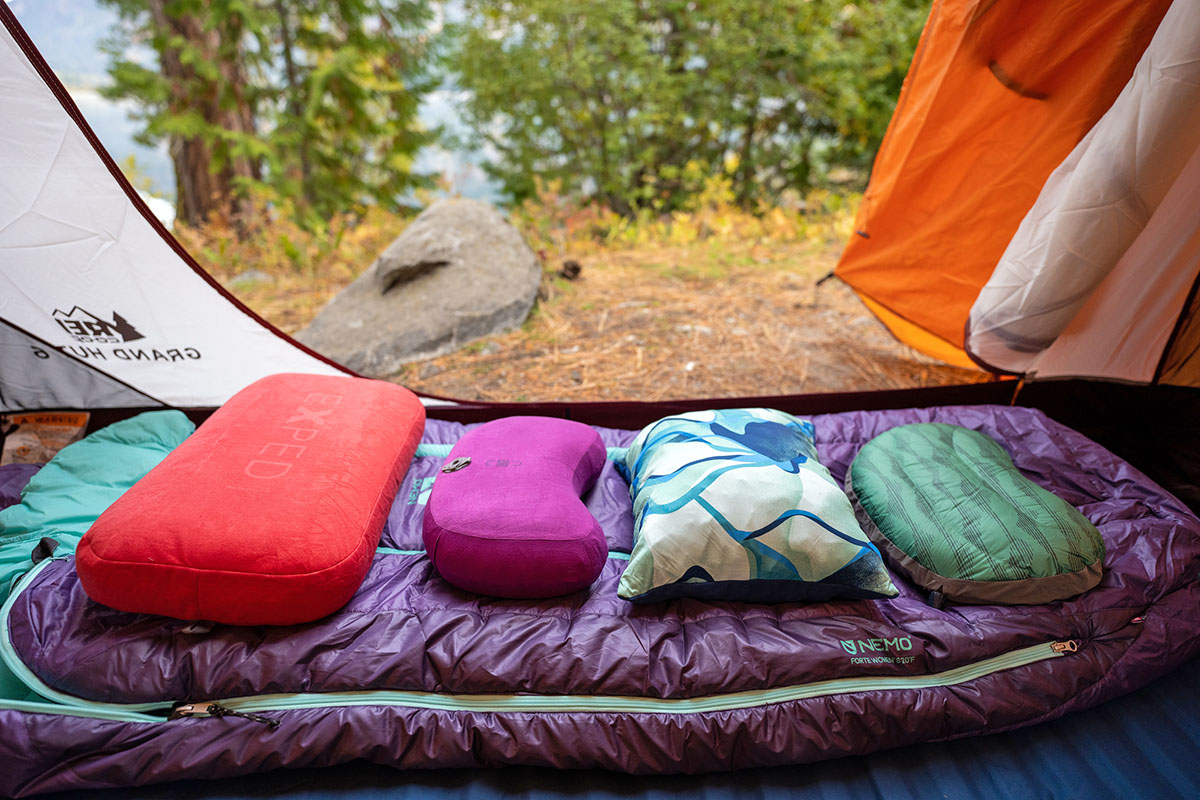
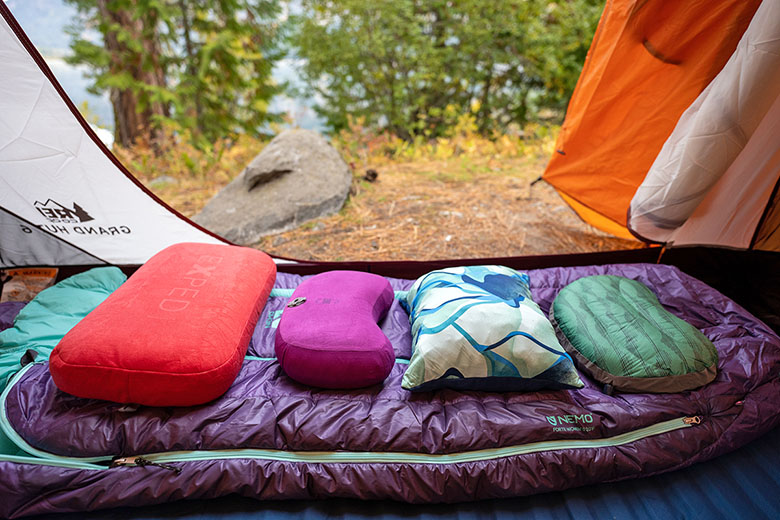
While small and relatively unassuming, a quality outdoor pillow can go a long way toward improving your sleep, whether you’re spending the night at your local state park or trekking miles into the backcountry. Designs range from ultralight and compressible inflatable models for multi-day backpacking missions to plush memory foam designs for ultimate car camping luxury, with many of our picks offering a good balance of comfort and weight to pull double duty. We’ve been testing the full gamut since 2022, and below we break down our favorite 16 camping and backpacking pillows of 2025. For more background information, check out our detailed comparison table and buying advice below the picks, along with details about our testing process.
Editor’s note: We updated this guide on May 6, 2025, to move the Nemo Fillo up in our rankings, dethroning the Therm-a-Rest Compressible Pillow Cinch as our favorite overall design. We also added the Zenbivy Ultralight pillow to our list, removed REI’s discontinued Trailmade Mummy Bag Pillow, and swept the article to ensure all information was up to date at the time of publishing.
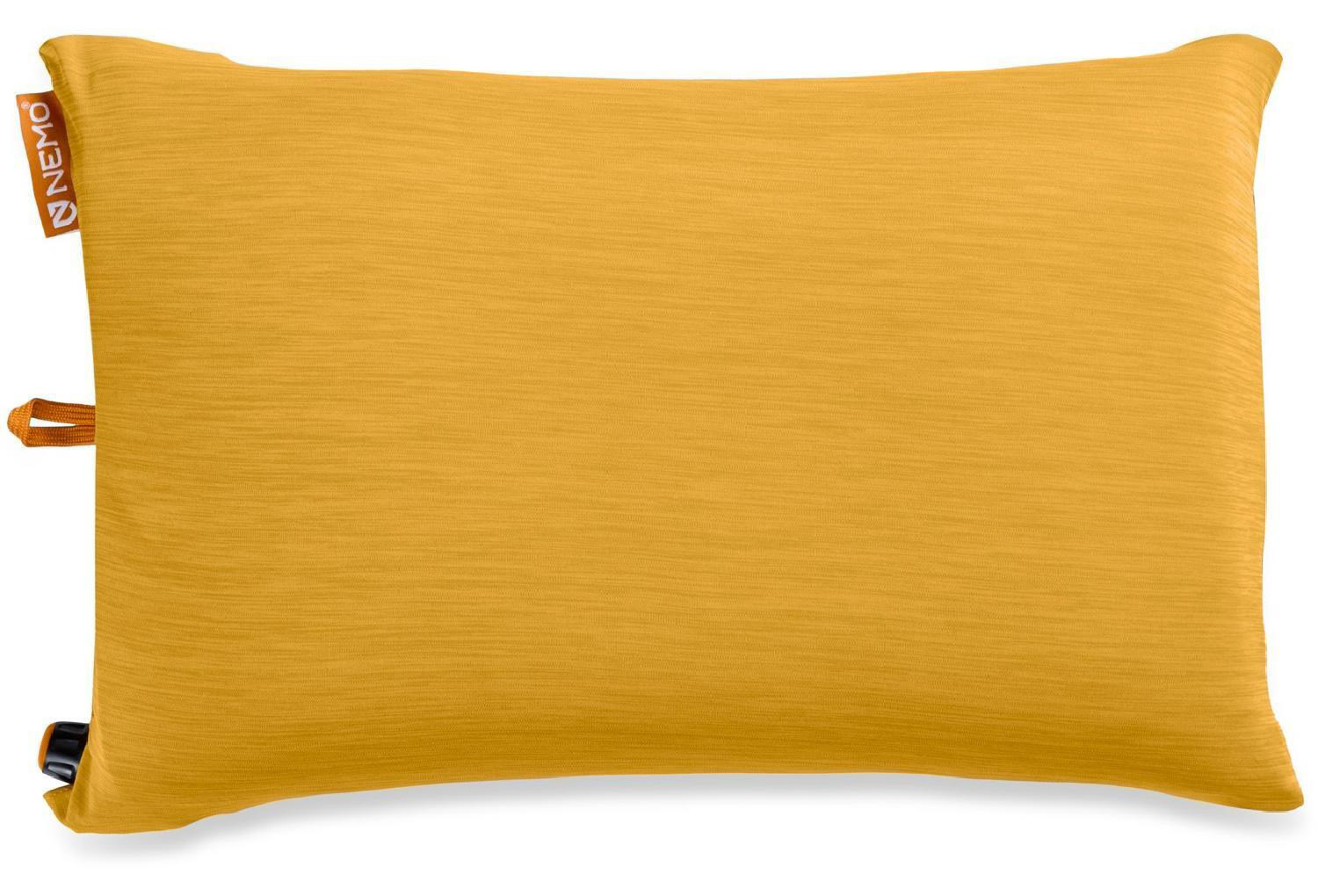 Best for: Camping and backpacking
Best for: Camping and backpacking
Type: Inflatable w/ foam
Weight: 9.2 oz.
Dimensions: 17 x 11 x 4 in.
What we like: Combination of air and foam offers great cushioning and support with minimal bulk.
What we don’t: Too small for some and difficult to get back into its stuff sack.
Utilizing a hybrid foam/air construction, Nemo’s Fillo Pillow is a bit lighter and far more compressible than all-foam alternatives without any major impact on sleeping comfort. All in all, it’s a simple but well-executed design: Once removed from its attached stuff sack, the foam inside will begin to inflate, and you can top it off by blowing into the air valve at the side, which is easy to open and close with a quick twist. This gives the Fillo a super plush and premium feel without the balloon-like shape of standard inflatable designs like Sea to Summit’s Aeros offerings below. And at a respectable 6 by 4 inches when compressed, the Fillo is entirely manageable for bringing along on the occasional backpacking trip. Taken together, it’s a well-rounded design that we’re always happy to lay our head on after long days outside.
No pillow is perfect, however, and the Nemo Fillo does come with a few downsides. First, at 17 inches long and 11 inches wide, it’s noticeably smaller than an alternative like Therm-a-Rest’s Compressible Pillow Cinch below, which measures 18 x 13 inches for the “regular” size. It’s also thinner at 4 inches compared to the Therm-a-Rest’s 6-inch-thick build, which is a downside for side sleepers and those prone to tossing and turning throughout the night. It’s worth noting that Nemo does offer larger options in the collection—including the Fillo Wide and Fillo King Luxury—but they will run you an additional $10 to $25. A final complaint is that the Fillo takes some patience and finesse to get back into its stuff sack—we’ve found it works best to fold it in half lengthwise before rolling it up. But there’s a reason this pillow is so popular: If the dimensions work for you, the Fillo packs in excellent comfort and support for its weight and size.
See the Nemo Fillo Pillow
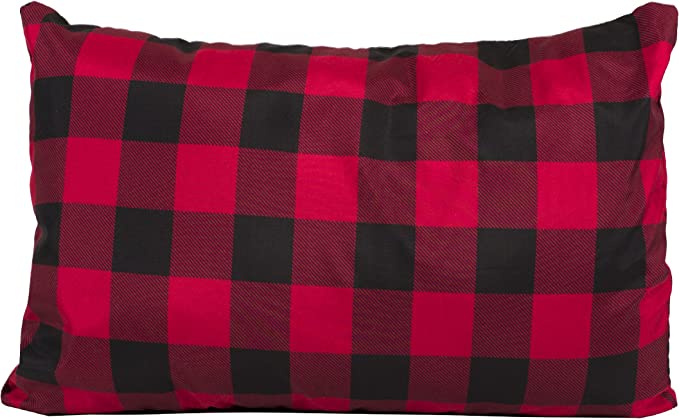 Best for: Camping
Best for: Camping
Type: Synthetic
Weight: 9.6 oz.
Dimensions: 12 x 18 in.
What we like: Cozy flannel exterior and washable design at a solid value.
What we don’t: Cheaper materials add weight and bulk; too soft for some.
Camp pillows are inherently a pretty affordable bunch, but that doesn’t mean there aren’t great deals to be found. Teton Sports’ Camp Pillow is a shining example: For just $24 full price and often available for less on Amazon, this pillow boasts a brushed flannel exterior that’s reminiscent of the brand’s plush sleeping bags. This is entirely subjective, but we also love the checkerboard-like patterning that gives off cozy cabin and outdoorsy vibes. Teton also included a handy drawstring-equipped storage bag for travel, as well as a removable pillowcase for easy cleaning—simply toss it in the wash with other clothing at the end of your trip. All told, it’s a no-frills but entirely practical option for most campers.
What do you sacrifice by saving with the Teton Sports Camp Pillow? As with most budget designs, the materials are on the cheaper end, which translates to added heft and bulk compared to more premium competitors like the Nemo Fillo above. Further, the synthetic fill doesn’t loft evenly when uncompressed, which can lead to air pockets and lumpiness. It also has a softer feel in general and lacks the firmness and support of many other picks here, plus there’s no cinch cord or valve to add air for additional structure. But if you prefer a soft pillow and want to keep costs low, the Teton Sports Camp Pillow is a solid value for what you get and comes in a healthy assortment of colorways.
See the Teton Sports Camp Pillow
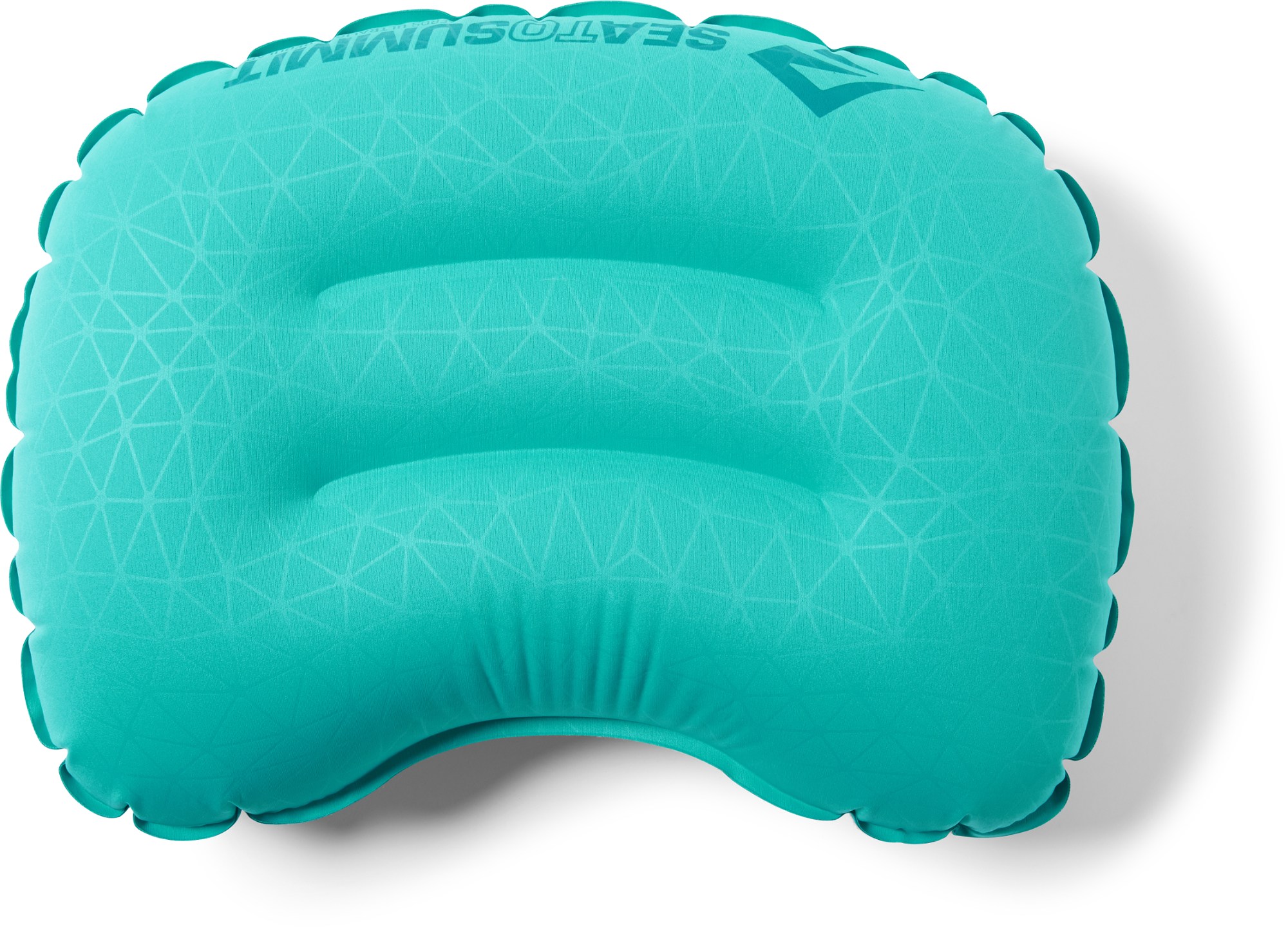 Best for: Backpacking
Best for: Backpacking
Type: Inflatable
Weight: 2.1 oz. (Regular)
Dimensions: 14.2 x 10.2 x 4.7 in.
What we like: Extremely light and takes up minimal space in a pack.
What we don’t: Lacking in plushness and durability; prone to sliding around when fully inflated.
The pillows above offer great comfort and support for car camping, but for minimalist backpacking adventures that take us deep into the backcountry, we turn to ultralight inflatable designs like Sea to Summit’s Aeros collection. Clocking in at a scant 2.1 ounces, the Aeros Ultralight Pillow here is the lightest model in the lineup and well suited for multi-day trips when you’ll want to keep weight to a minimum. Packed size is equally impressive: The pillow compresses down to about the size of a baseball, making it a no-brainer to bring along even on gear-intensive missions when space is at a premium. Finally, despite its ultralight build, the Aeros includes thoughtful touches like quick and easy inflation via the low-profile valve (it just takes a couple breaths), a soft stretch-knit fabric that’s comfortable against the skin, and curved internal baffles to keep your head centered on the pillow.
We’ve been using Sea to Summit’s Aeros Ultralight for multiple seasons, and it quickly became a must-have item in our pack. That said, on car camping adventures, we typically leave the Aeros behind and instead opt for a plusher foam option like the Nemo Fillo above or Therm-a-Rest’s Compressible Pillow Cinch below. While heavier, these pillows offer a sizable boost in all-night comfort with softer materials and larger dimensions. We’ve also found the Aeros prone to sliding around when fully inflated unless secured inside the hood of a mummy bag (many campers opt for roomier rectangular bags that typically forgo hoods). Alternatively, all of Sea to Summit’s sleeping pads come with adhesive hook-and-loop patches to secure their pillows in place. A final gripe is the Aeros’ thin 20-denier (D) shell, which has a delicate feel and gives us pause around sharp gear (although we haven’t had any issues to date). But for backpackers who want to keep things light without forgoing some creature comforts, the Aeros Ultralight has its place.
See the Sea to Summit Aeros Ultralight
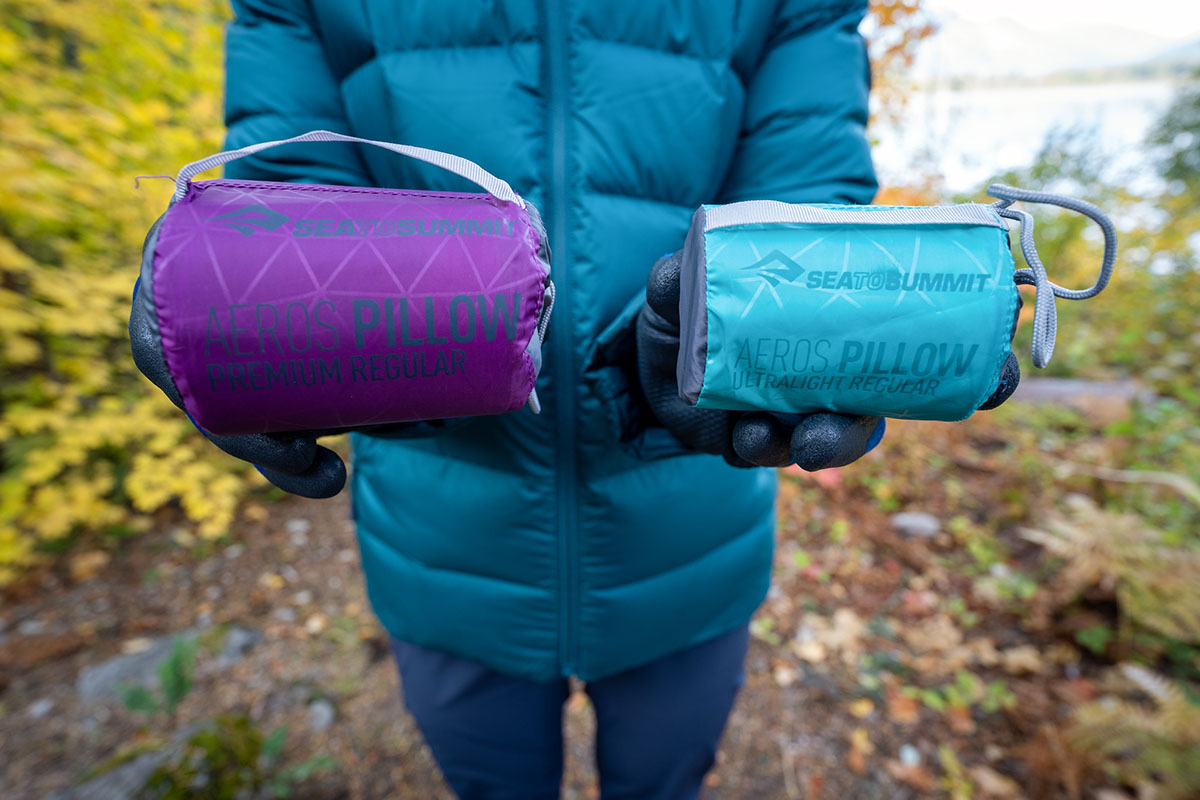
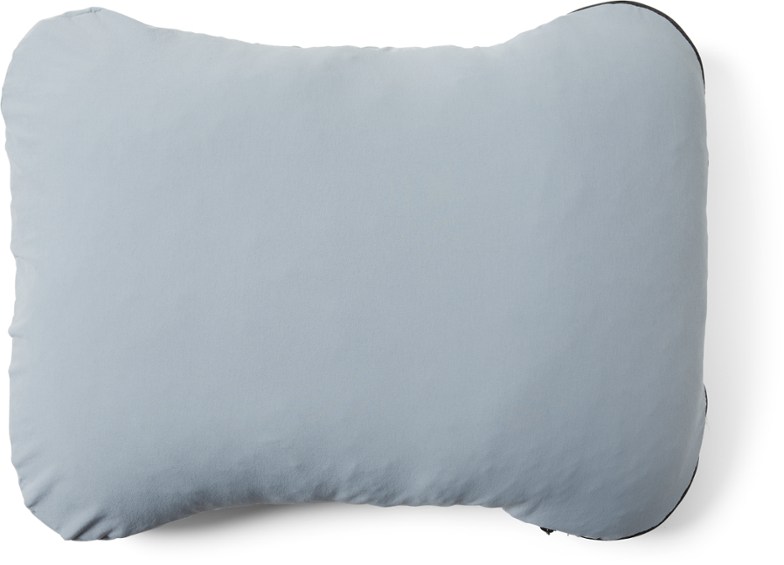 Best for: Camping
Best for: Camping
Type: Memory foam
Weight: 2 lb. 3.2 oz. (Medium)
Dimensions: 22 x 15 x 8 in.
What we like: A thick and luxurious camping pillow that can pull double duty at home for guests.
What we don’t: The heaviest, bulkiest, and priciest option on our list.
Hest has broken into the car camping scene with a Yeti cooler-like focus on quality. The brand’s Camp Pillow is a case in point, utilizing a premium blend of memory foam and polyester in a generous, 8-inch-thick design for excellent support and structure, especially for side sleepers. The stretch-woven nylon exterior is also very soft against the skin, while the curved shape helps cradle your head and neck. All of the smaller details are equally well sorted, including zippered access to fine-tune height and firmness, a PU coating along the shell for added assurance against moisture and stains, and a removable and washable cover for easy cleaning. And when it's time to pack up camp, simply turn the pillow inside out and zip the cover shut—there’s also a built-in carry loop for clipping to a duffel or pack. All told, it’s a luxurious-feeling pillow that will likely make you forget you’re sleeping in the woods and can easily pull double duty at home for guests.
All that said, there are some major downsides to the Hest Camp Pillow’s decidedly luxe design. First is weight: At 2 pounds 3.2 ounces for the medium size, the Hest is the heaviest option here by a wide margin. It’s also the bulkiest, which means it’s best suited for car campers who aren’t limited on space. Finally, at $89, you’re paying a pretty steep premium for the high-end materials and construction. You can certainly bring along your pillow from home as a substitute, but the Hest's dirt- and water-resistant cover and integrated stuff sack add sizable benefits for long-term outdoor use. In the end, the Hest will be overkill for some, but it leaves little to be desired for serious comfort seekers. Hest also offers the design in small and large sizes, which cost $74 and $119, respectively.
See the Hest Camp Pillow
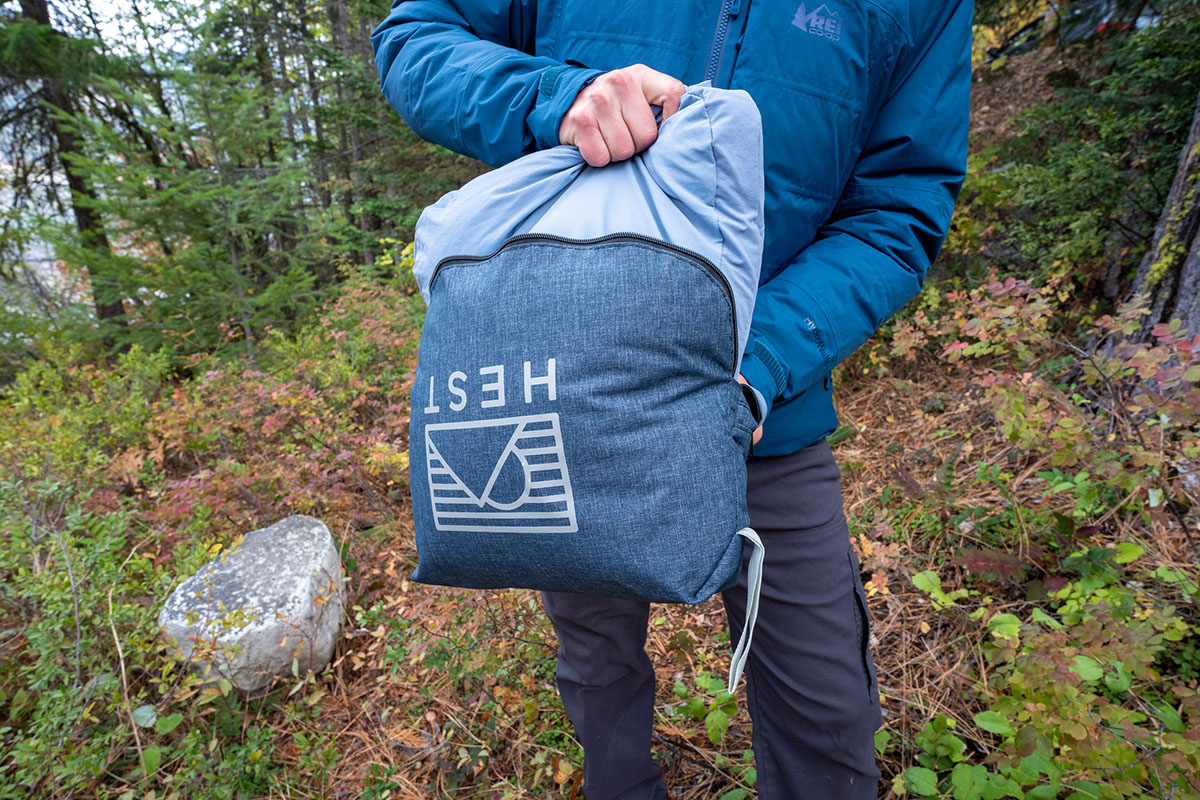
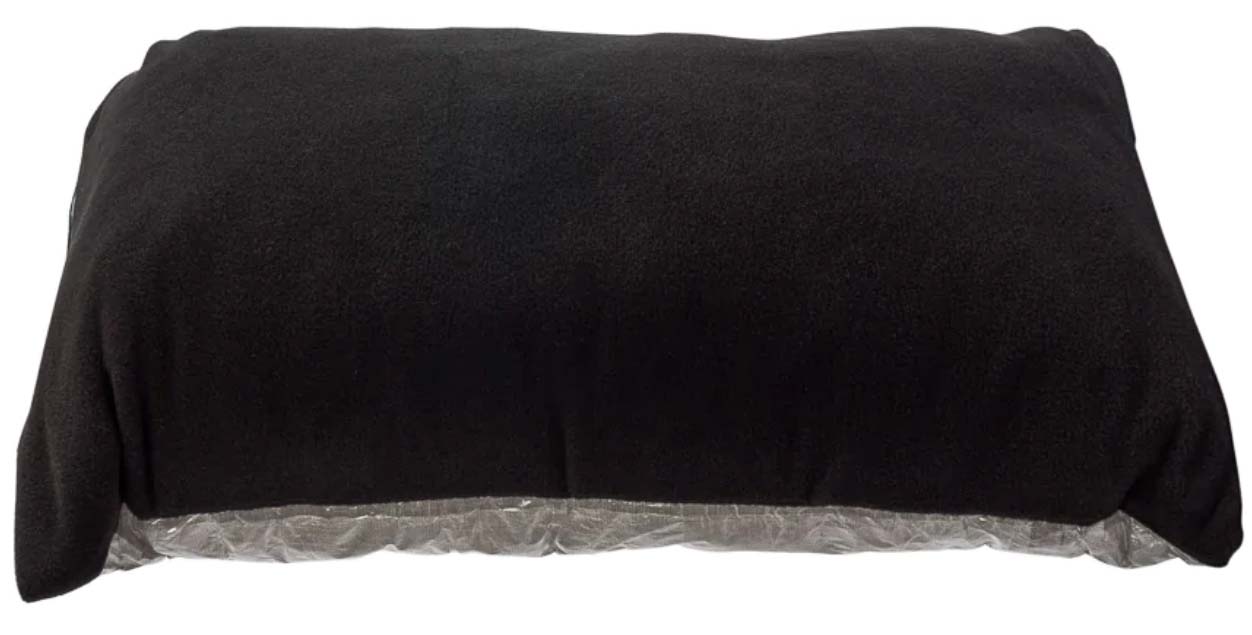 Best for: Backpacking
Best for: Backpacking
Type: Stuff sack pillow
Weight: 1.6 oz.
Dimensions: 11.25 x 20 in.
What we like: A dual dry bag/pillowcase that’s extremely light and waterproof.
What we don’t: Not a great value; most backpackers will prefer a traditional pillow.
For minimalists and ultralight adventurers who scoff at adding unnecessary ounces to their base weight, a stuff sack pillow could be a good compromise. Essentially specialized pillowcases, these designs are uninsulated and provide a space to stuff extra clothing (which you’re already carrying) to create a makeshift pillow at night. Zpacks’ Medium-Plus Pillow is our favorite option in this category and stands out for its versatility: Made with highly water-resistant Dyneema fabrics and protective details like fully taped seams and a waterproof main zipper, the pillow can function as a dry bag to protect your gear on the trail. At night, simply turn the Medium-Plus inside out to reveal the soft microfleece surface and stuff any spare clothes inside for use as a pillow. At just 1.6 ounces, the Medium-Plus adds a negligible amount of weight to your pack, and the dual-purpose build makes it even easier to justify.
In terms of downsides, stuff sack pillows like the Zpacks Medium-Plus aren’t as intuitive or user-friendly as traditional designs. In short, it can be difficult and time-consuming to achieve an even and consistent packing job—rather than just inflating the pillow, you’ll need to take some time to intentionally stuff clothing inside until you reach your desired firmness. The bottom of the pillow (without the microfleece) also tends to slide around throughout the night, and we recommend purchasing Zpacks’ Pillow Attachment Cord (a $6 add-on) to keep it in place. Finally, at $60, the Medium-Plus is pricey for what you get, and most recreational backpackers will be better off saving with an option like the Sea to Summit Aeros Ultralight above (which is just 0.5 oz. heavier) or the Zenbivy Ultralight Pillow below (0.8 oz. heavier). But for weight- and space-conscious missions, the Zpacks’ two-in-one design certainly has its appeal. For a similarly built option from another leading UL brand, check out Hyperlite Mountain Gear’s Stuff Sack Pillow ($59 and 1.7 oz.).
See the Zpacks Medium-Plus Pillow
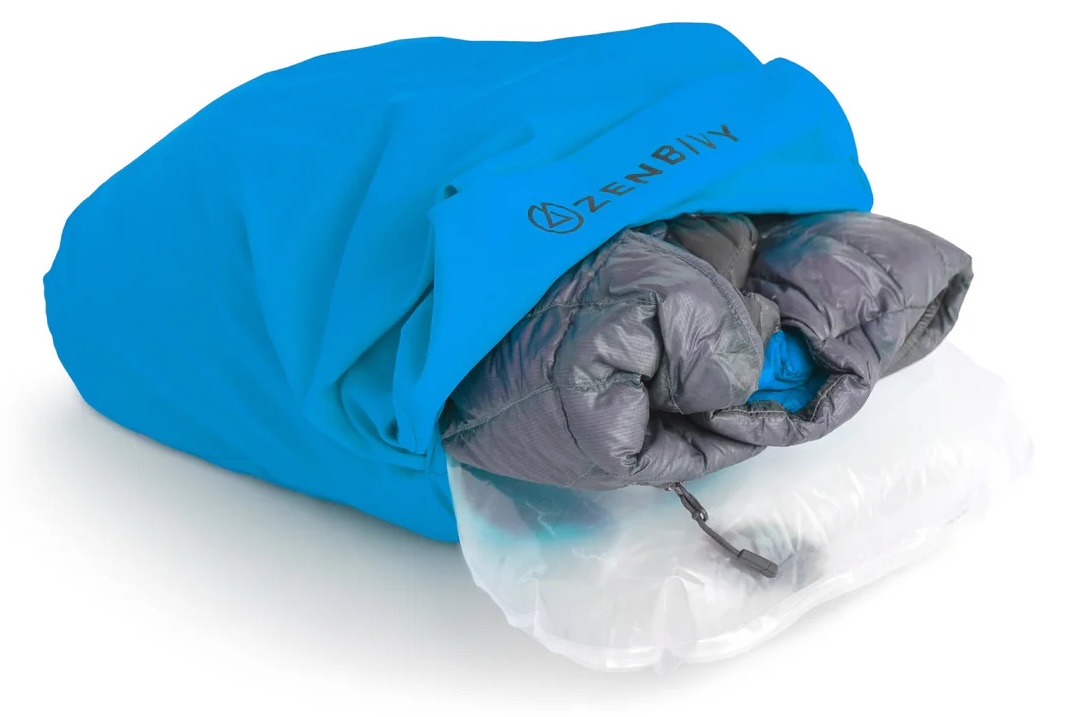 Best for: Backpacking
Best for: Backpacking
Type: Stuff sack w/ inflatable
Weight: 2.4 oz. (Regular)
Dimensions: 14 x 10 x 3.5+ in.
What we like: Design allows for a lot of customization; great price.
What we don’t: Bladder is relatively fragile; smaller dimensions (though a larger size is available).
The Zenbivy Ultralight Pillow is a simplified version of the brand's three-piece SoftTop Pillow, but by foregoing the SoftTop's down pillow topper, you shed 3.5 ounces and save $40. What you're left with is the air bladder and a pillowcase with extra room to add your down jacket or other clothes to dial in the perfect feel. This hybrid design means you get the supportive boost of an inflatable pillow while also saving weight by using the clothes you already have to fill extra space (similar to the Zpacks above). The air bladder alone inflates to 3.5 inches, which we found very cozy on a three-day backpacking trip through the Wind River Range in Wyoming. And the pillowcase can get stuffed with an extra 1.5 inches of clothes to reach a luxurious 5 inches in total. At just 2.4 ounces for the regular size and only $32, this is a hard-to-beat option for anyone weight- or budget-conscious (or both).
At almost half the cost of the Zpacks Medium-Plus Pillow above (which is essentially just a fancy pillowcase), why do we have the Zenbivy Ultralight ranked lower? While we love the versatility of the Zenbivy, the Zpacks is still the smarter choice for the dedicated ultralight backpacker. The air bladder in the Zenbivy is a bit fragile, and left with just the pillowcase, it's not as large or as cozy as the fleece-lined Zpacks sack. That said, the Zenbivy Ultralight does come in a large size that's closer to the dimensions of the Zpacks (18 x 11 x 3.5+ in.) for only $3 more than the regular size featured here. And if you already own Zenbivy products like their Ultralight Sheet, then getting their pillow is a no-brainer because it has built-in "headboard clips" to attach to your sheet and keep everything nicely in place.
See the Zenbivy Ultralight Pillow
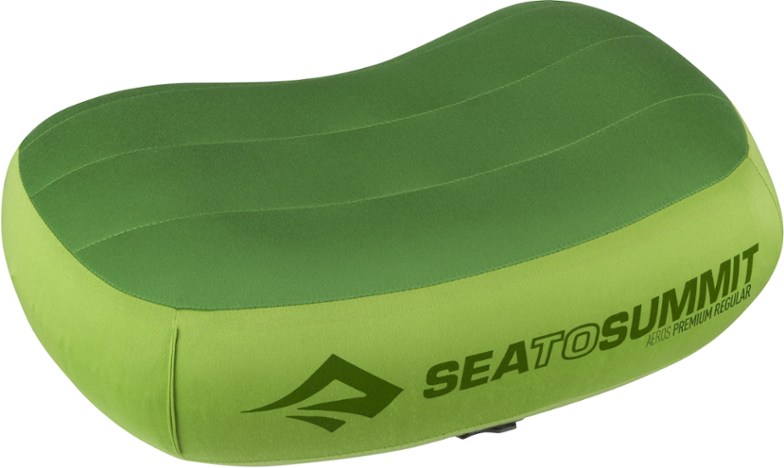 Best for: Backpacking
Best for: Backpacking
Type: Inflatable w/ synthetic
Weight: 2.8 oz. (Regular)
Dimensions: 13.4 x 9.4 x 4.3 in.
What we like: Better comfort and durability than the Aeros Ultralight above for less than an ounce more.
What we don’t: Smaller dimensions and still prone to sliding around throughout the night.
The second Sea to Summit model to make our list this season is their Aeros Premium Pillow, which offers a step up in comfort and durability compared to the Aeros Ultralight above. For just 0.7 ounces more, the Aeros Premium adds a light layer of synthetic insulation between the top surface and TPU air bladder, which gives the pillow a slightly plusher and cozier feel. The Aeros Premium also has a noticeably thicker 50D shell, which feels much more confidence-inspiring around sharp gear than the 20D Aeros Ultralight. The rest of the design is largely similar to the UL model, including an intuitive multi-function valve for easy inflation and deflation, curved internal baffles to keep your head in place, and a scalloped bottom edge to help the pillow stay centered around your shoulders when you’re sleeping or relaxing in your camp chair before bed.
Why do we have the Sea to Summit Aeros Premium ranked below the Aeros Ultralight? Despite the clear advantages in all-around comfort and durability, the Premium is a little smaller at 13.4 inches wide and 9.4 inches long (versus 14.2 x 10.2 in. for the Ultralight). It’s also a little thinner at 4.3 inches compared to the Ultralight’s 4.7-inch-thick build, which is a potential downside for side sleepers and those prone to tossing and turning. Finally, like the Ultralight, the Aeros Premium tends to slide around when fully inflated—it works best in a mummy bag when you can stuff it inside the hood to secure it in place (alternatively, it will also work with one of Sea to Summit’s PillowLock-equipped sleeping mats). That said, you’d be hard-pressed to find better comfort and durability for the weight, making the Aeros Premium a nice alternative to the Ultralight above for backpackers who are hard on their gear.
See the Sea to Summit Aeros Premium
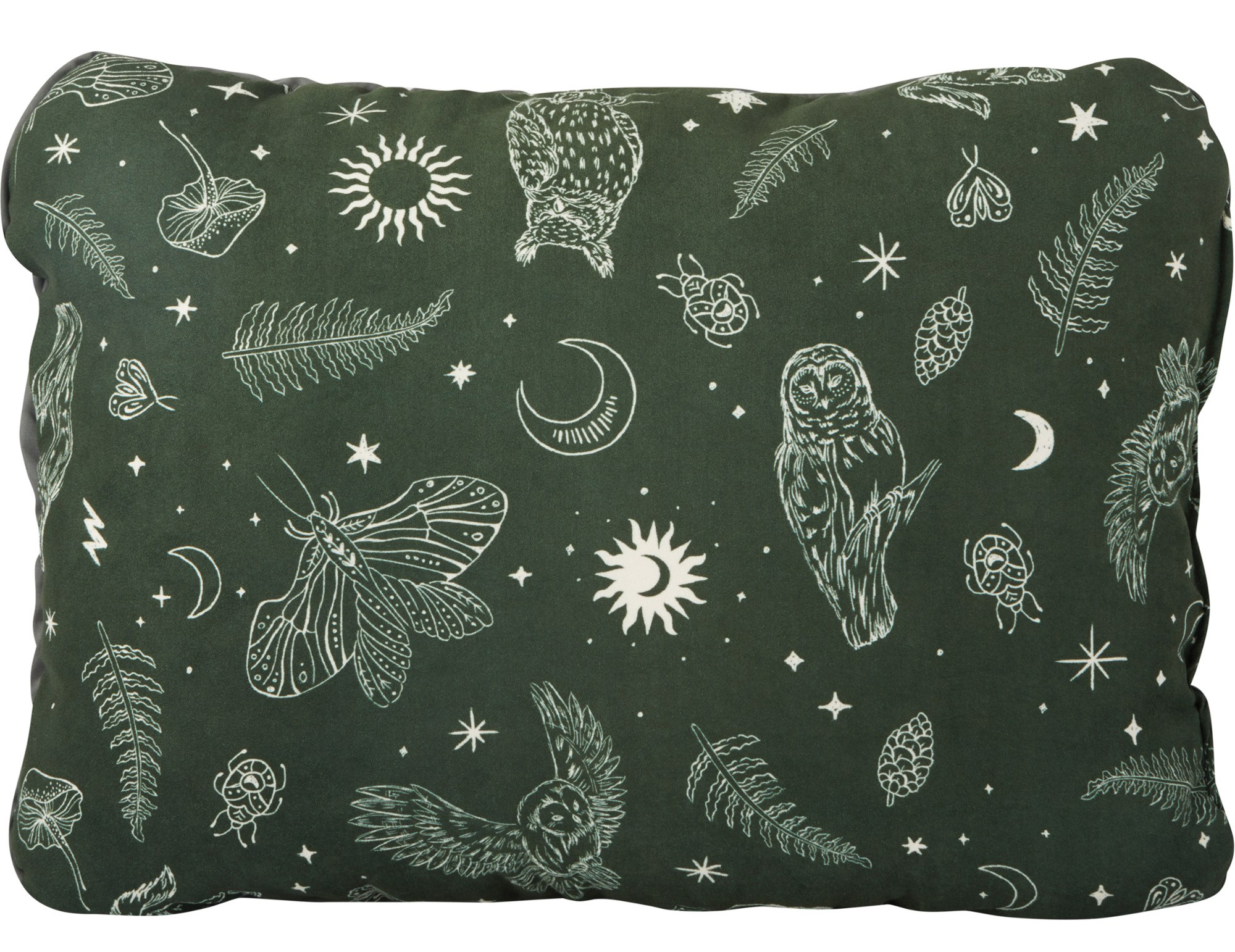 Best for: Camping
Best for: Camping
Type: Self-inflating foam
Weight: 11.5 oz. (Medium)
Dimensions: 18 x 13 x 6 in.
What we like: Soft exterior, good compressibility, and cinch cord makes it easy to tailor firmness.
What we don’t: A little heavy and bulky for backpacking; foam takes some time to expand.
Therm-a-Rest makes some of our favorite sleeping pads on the market, and that expertise transfers over nicely to their pillow collection. During testing, their Compressible Pillow Cinch was quick to win us over: The exterior uses a soft and supple polyester cover, while the inside is filled with compressible but supportive foam that’s been upcycled using excess material from their sleeping pads. We’re also big fans of the cinch cord at the side, which allows you to tailor firmness depending on your sleeping preferences. Therm-a-Rest also added an additional layer of light insulation at the top, which is intended to minimize lumps. And a final bonus: The pillow is machine-washable—simply throw it in with your other clothing when it needs a cleaning.
What’s not to like with the Therm-a-Rest Compressible Pillow Cinch? First is the lack of backcountry appeal: Despite its “compressible” designation, the pillow’s foam insulation adds weight and bulk and doesn’t allow it to stuff down small for backpacking missions. For comparison, inflatable designs like Sea to Summit’s Aeros Ultralight above are far lighter (by over 9 oz.) and more compressible, although they come with drawbacks in terms of comfort and durability. The Therm-a-Rest’s foam also takes some time to expand—we recommend undoing the cinch cord as soon as you get to camp and fluffing it up to speed up the process. Compression requires similar planning, including rolling it twice to smooth things out before packing away. Despite these drawbacks, the Compressible Pillow offers solid comfort and support for the weight, earning it a respectable finish on our list this season.
See the Therm-a-Rest Compressible Pillow Cinch
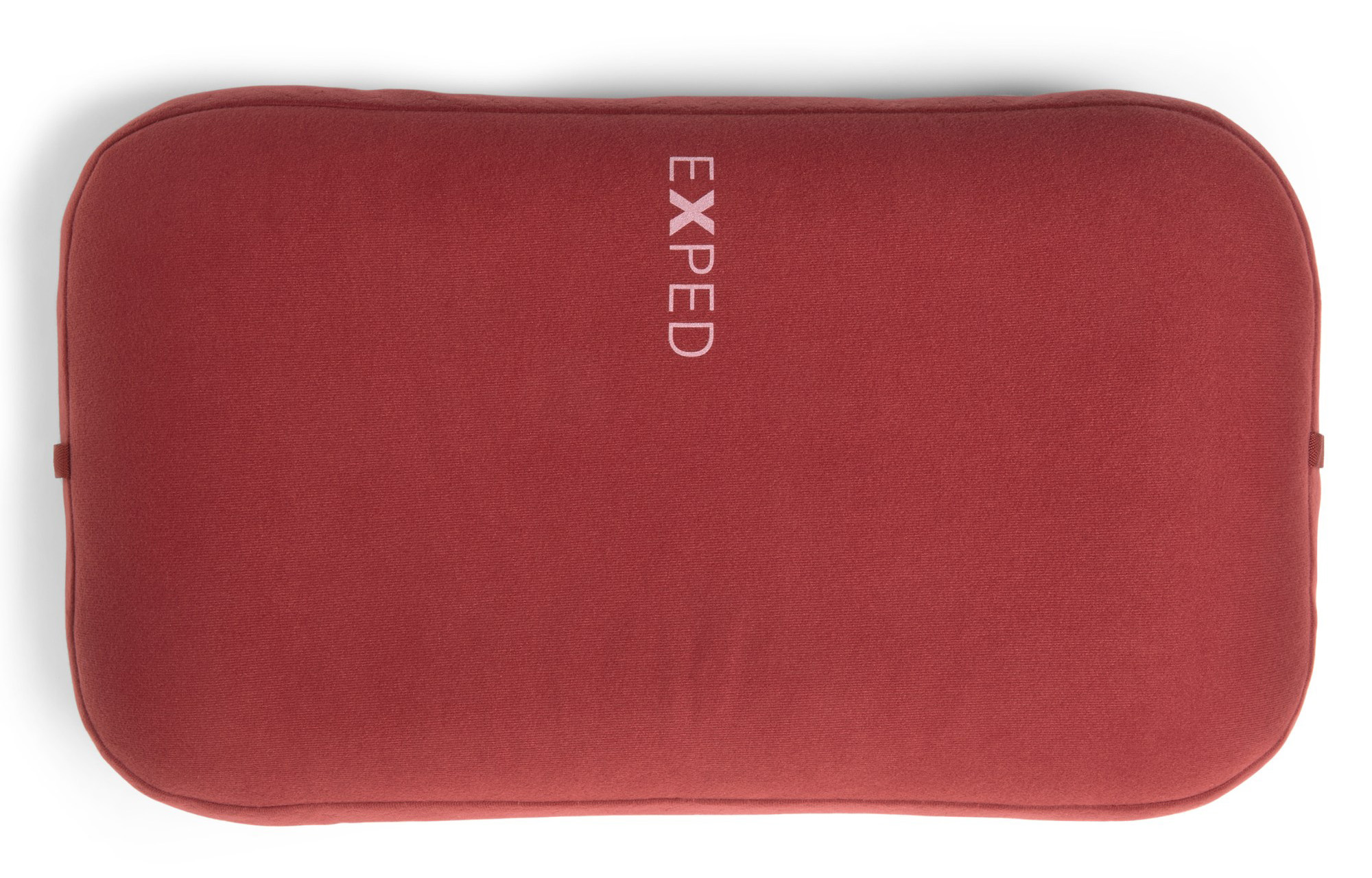 Best for: Camping
Best for: Camping
Type: Inflatable w/ synthetic
Weight: 6.0 oz.
Dimensions: 20.5 x 12.6 x 4.7 in.
What we like: Generous dimensions and Exped’s proven sleeping mat tech in a soft and premium-feeling package.
What we don’t: Rectangular shape makes it difficult to stuff inside a mummy bag; not the best value.
Exped’s MegaMat is legendary in the camping world, offering excellent cushioning and support that rival the comfort of your at-home mattress. Their Mega Pillow sticks to a similar formula, combining high-end materials and Exped’s proven tech in a premium-feeling package. Like the MegaMat, the Mega Pillow boasts near-vertical sidewalls designed to maximize the amount of surface area for your head. The tricot nylon exterior also has a velvety feel that’s noticeably soft against the skin and is backed with a layer of synthetic insulation for added coziness and comfort. Exped didn’t skimp on the smaller details, either, including fabric eyelets at the sides for attaching to a sleeping mat, a removable air cushion for easy cleaning, and a low-profile valve that doesn’t protrude and makes fine-tuning firmness quick and easy. Finally, at 20.5 inches wide and 12.6 inches long, the aptly named Mega Pillow is one of the largest options here while checking in at a very manageable 6 ounces.
What pushed the Exped Mega Pillow to a mid-pack finish? While comfort seekers will love the generous dimension, the rectangular shape doesn’t nestle easily into the hood of a mummy bag, which most backpackers (and some campers) prefer. If you anticipate using your pillow for both camping and backpacking adventures, Exped’s DeepSleep Pillow (6.3 oz.) and Down Pillow (5.3 to 6.7 oz. depending on size) are slightly smaller but have curved shapes that are more sleeping bag-friendly. But there’s little to be desired from a comfort perspective, which lands the Mega Pillow midway up our list.
See the Exped Mega Pillow
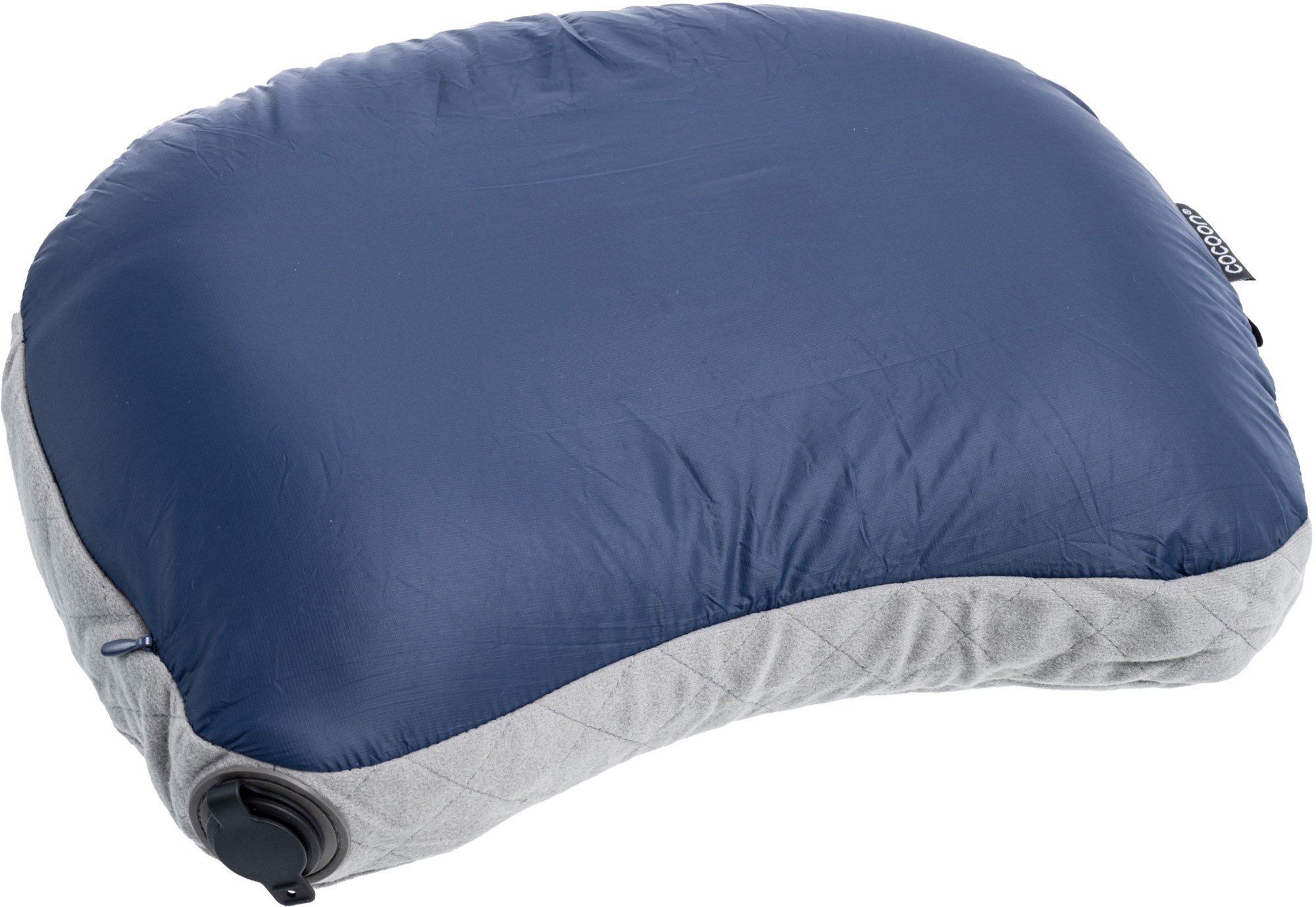 Best for: Backpacking
Best for: Backpacking
Type: Inflatable w/ synthetic
Weight: 3.8 oz.
Dimensions: 14.6 x 11 x 4 in.
What we like: Double-sided design is great for tailoring warmth depending on conditions.
What we don’t: Not a standout in packability and too small for some.
Cocoon may lack the name recognition of brands like Therm-a-Rest and Sea to Summit, but we’ve had positive experiences with their pillow collection thus far. Our favorite in their lineup is the Air-Core Hood/Camp Pillow, which is similar to designs like the Sea to Summit Aeros Premium above and Nemo Fillo Elite Wide Ultralight below with an inflatable air bladder surrounded by synthetic fill for added support and comfort. Where the Cocoon sets itself apart is versatility: The pillow is double-sided with cozy polyester microfiber on one side for cold nights; in balmy weather, flip it over to reveal smooth nylon that feels cool and soft against the skin. We also found it easy to adjust the amount of air inside with a simple push of the valve at the bottom corner. Finally, the pillow’s curved shape pairs well inside a mummy bag, and the hidden zipper allows you to quickly remove the cover for cleaning (Cocoon recommends washing by hand).
In comparing the Cocoon Air-Core to other leading designs, the polyester microfiber side felt quite a bit softer and plusher than other ultralight designs we’ve tested, including Therm-a-Rest’s Air Head Lite (a lighter version of the standard Air Head below). That said, despite the competitive 3.8-ounce weight, the Cocoon’s 4.7 x 3.1-inch packed size is on the larger end in the UL category, and we found it a little tough to compress the pillow into its stuff sack. At 14.6 inches wide and 11 inches long, it’s also smaller than competitors like the Air Head Lite (15.5 x 11 in.) and Nemo's Fillo Elite Luxury (21 x 11 in.) below. But the Cocoon is the most versatile of the bunch with its double-sided design, and it’s also the cheapest at $35. The rest of the brand’s lineup is equally well executed, including the roomier, rectangular Air-Core Ultralight and feathery, 2.7-ounce Air-Core Hyperlite.
See the Cocoon Air-Core Hood/Camp Pillow
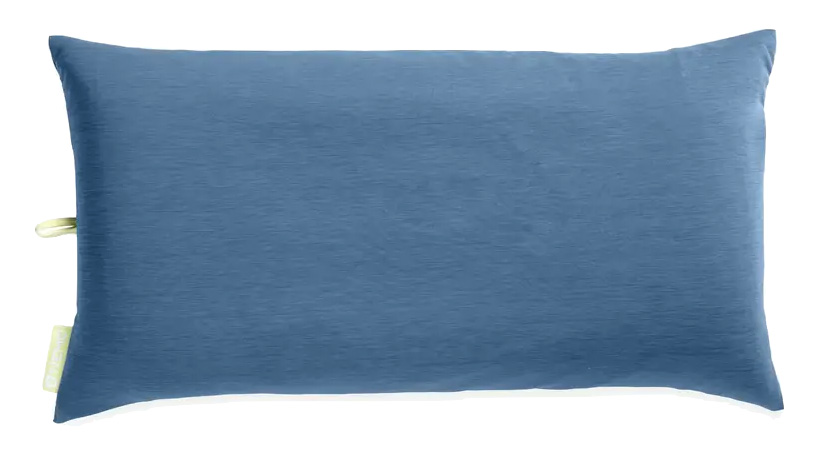 Best for: Backpacking and camping
Best for: Backpacking and camping
Type: Inflatable w/ synthetic
Weight: 4.0 oz.
Dimensions: 21 x 11 x 3 in.
What we like: Lighter and more packable than the standard Fillo with little impact on comfort.
What we don’t: Also thinner and less sleeping bag-friendly.
Nemo's Fillo above was quick to win us over on car camping trips, but some backpackers may find it too heavy and bulky to warrant packing on long backpacking missions. For this type of use, we turn to the Fillo Elite Wide Ultralight, which trades the standard model’s foam insulation for lighter and more compressible PrimaLoft synthetic fill. The result is a sizable drop in both weight and packed size, with the Fillo Elite Wide Ultralight checking in around 5 ounces lighter and compressing down to just 5 x 3 inches in its integrated stuff sack (compared to 6 x 4 in. for the standard Fillo). The rest of the build lines up similarly, including a soft and cozy cover that’s machine-washable, easy inflation and deflation via the ergonomic valve, and Nemo's baffled air cell tech that helps distribute the air evenly across the entire surface of the pillow. Taken together, the Fillo Elite Wide Ultralight is a nice upgrade over the standard Fillo for backpackers who want to keep things light without skimping on all-night comfort.
In addition to being lighter and more compressible than the Fillo above, the Nemo Fillo Elite Wide Ultralight is also wider by 4 inches, which has its pros and cons. On the plus side, the roomy rectangular shape will feel more like your pillow at home. However, similar to our complaint with the Exped Mega Pillow above, it’s too large to fit inside the hood of most mummy bags. If this is a dealbreaker for you, Nemo also offers standard Fillo Elite Ultralight, which is 6 inches narrower, 1.2 ounces lighter, and $10 cheaper. Both pillows are on the thinner end at 3 inches thick, and side sleepers will likely prefer additional padding (like what you get with Sea to Summit’s 4.3-inch-thick Aeros Premium above). But if the thickness and shape work for you, the Fillo Elite Wide Ultralight is impressively light and comfortable for its size.
See the Nemo Fillo Elite Wide Ultralight
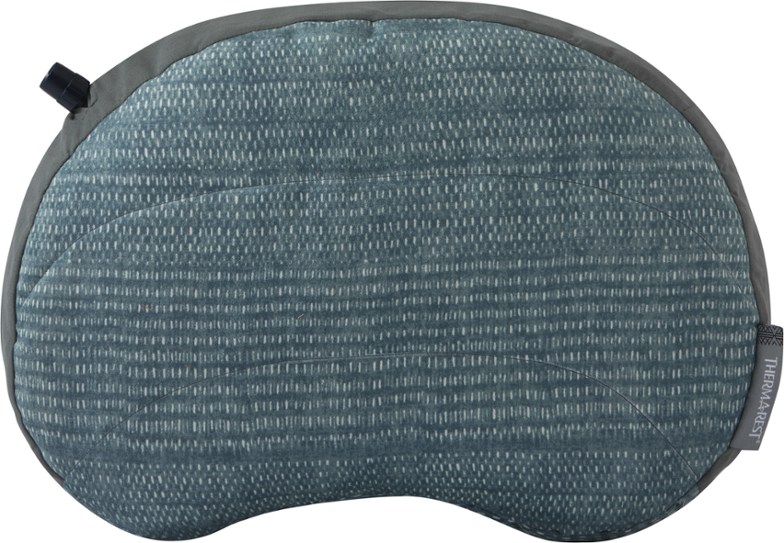 Best for: Camping and backpacking
Best for: Camping and backpacking
Type: Inflatable w/ synthetic
Weight: 5.6 oz. (Regular)
Dimensions: 15.5 x 11 x 4 in.
What we like: A well-rounded and versatile pillow for both camping and backpacking.
What we don’t: Plastic air bladder is noisy; not a durability leader.
Therm-a-Rest’s Compressible Pillow Cinch above is our favorite design from the brand, but the all-foam build makes it a little too heavy to cross over for backpacking. Enter Therm-a-Rest’s own Air Head, which uses a mix of air and lightweight synthetic insulation under the top surface to shave weight and minimize bulk. For reference, at 5.6 ounces, the Air Head clocks in around half the weight of the Compressible and packs down noticeably smaller inside its stuff sack, which gives it the clear edge for backcountry adventures. We also like the nonslip fabric along the bottom, which does a great job keeping the pillow in place (unlike Sea to Summit’s Aeros models above, which are noticeably slippery underneath). Tack on a removable cover for easy cleaning and a curved shape to nestle into the hood of your sleeping bag, and the result is a versatile design that works well for everything from multi-day backpacking missions to overnight camping trips and air travel.
Despite its well-rounded build, the Air Head does come with a few drawbacks. Our biggest complaints relate to the internal air bladder, which is on the thinner end and has been plagued by reports of punctures and premature leaks. The bladder’s plastic construction is also relatively crinkly and noisy, meaning finicky sleepers and those prone to moving around throughout the night should steer clear. Finally, the inflate/deflate valve is an old-fashioned design that sticks out the side of the pillow, which makes it less user-friendly when rolling up for storage. Of note: Therm-a-Rest does offer the 2-ounce Air Head Lite, which shares the same dimensions but forgoes the synthetic insulation to shave weight and bulk. And for a boost in comfort and support, you can upgrade to the 4.9-ounce Air Head Down, which is insulated with 650-fill duck down.
See the Therm-a-Rest Air Head
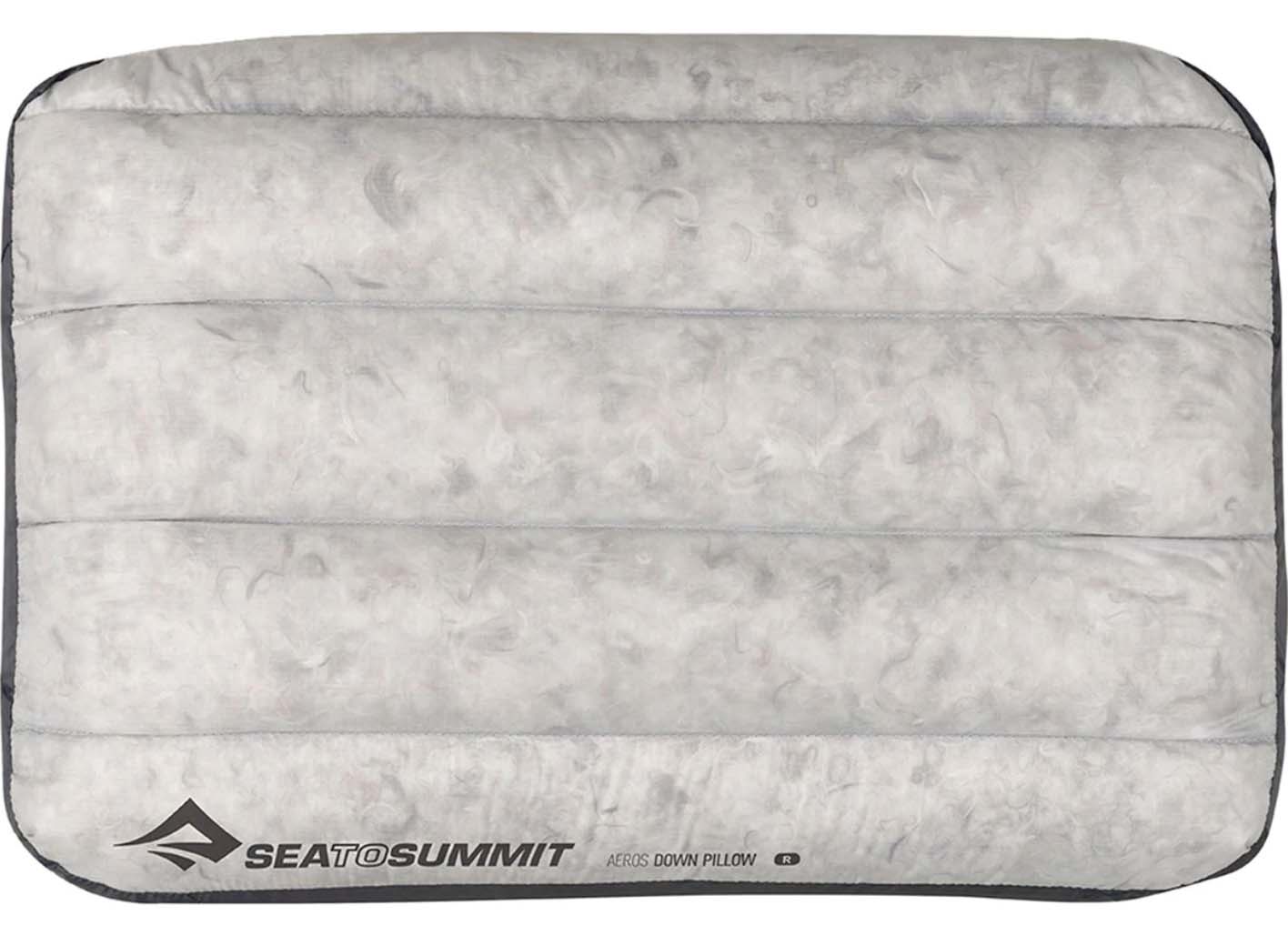 Best for: Backpacking
Best for: Backpacking
Type: Inflatable w/ down
Weight: 2.5 oz. (Regular)
Dimensions: 13.4 x 9.4 x 4.7 in.
What we like: Barely heavier than the Aeros Ultralight above with premium down cushioning for added warmth and comfort.
What we don’t: Expensive; ultralight fabrics are thin and relatively noisy and slippery.
Joining the other two Sea to Summit models above is the Aeros Down, which splits the difference between the Aeros Ultralight (2.1 oz.) and Premium (2.8 oz.) above at 2.5 ounces. It’s also the only model in the collection—and on our list—to include down cushioning along the top, which adds a nice boost in overall comfort and warmth while keeping things light and packable (down is known for being very warm for the weight and highly compressible). Adding to its ultralight focus, Sea to Summit utilized fabrics from their Spark sleeping bag collection, which are noticeably thin but reasonably tear-resistant (provided you exercise caution). Rounding out the design is a supportive TPU air bladder, low-profile inflation/deflation valve, and compatibility with Sea to Summit’s PillowLock system to secure the pillow to any of their sleeping mats.
However, like most specialized UL designs, the Sea to Summit Aeros Down isn’t a great all-rounder. While decently durable for how thin it is, the 10D shell has a delicate feel and will need to be treated with care to avoid punctures. The fabrics are also relatively noisy, slippery, and lack the soft hand feel that you get with the other Aeros models, which use plusher stretch-knit polyester along the top (you could always throw on a lightweight pillowcase to boost coziness). Finally, the Aeros Down forgoes the curved internal baffles and scalloped bottom edge of the Aeros Ultralight and Premium, which we appreciate for keeping our head in place throughout the night. But the down cushioning certainly has its benefits, including a modest boost in overall comfort and warmth with minimal impact on weight and bulk.
See the Sea to Summit Aeros Down
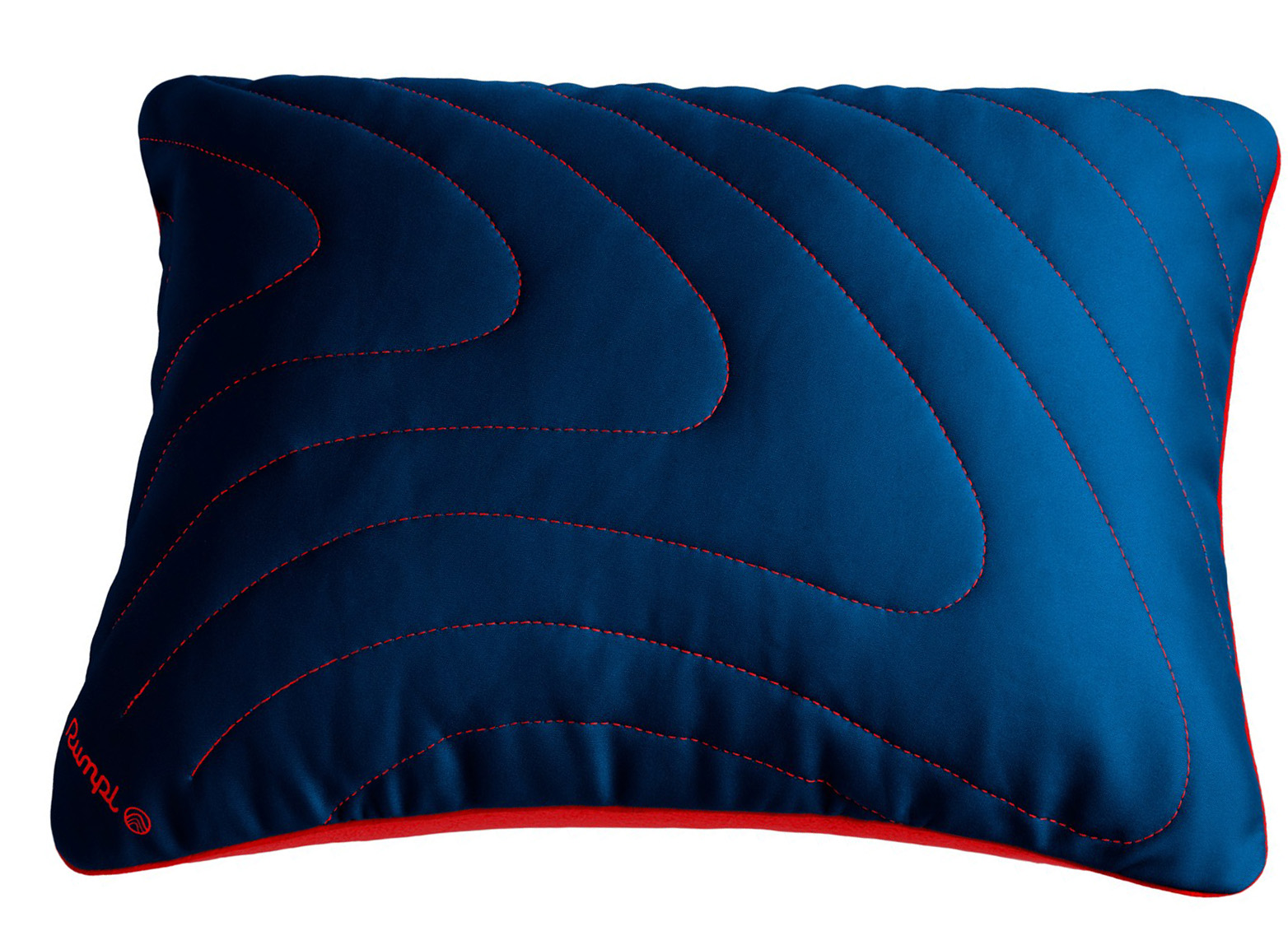 Best for: Camping and backpacking
Best for: Camping and backpacking
Type: Stuff sack pillow
Weight: 4.0 oz.
Dimensions: 12 x 17 in.
What we like: Much softer and more comfortable than the Z Packs Medium-Plus above.
What we don’t: Also heavier and less versatile.
Rumpl is best known for their modern and vibrant outdoor blankets, but they’ve more recently started to expand into the rest of the camping market. Their Stuffable Pillowcase is a logical addition to the lineup and competes with the Zpacks Medium-Plus above as a lightweight stuff sack pillow for minimalist campers and backpackers. The Rumpl’s biggest advantage over the Zpacks is comfort: The double-sided design is considerably plusher and softer with thick polar fleece on one side and smooth polyester on the other. Like most of Rumpl’s offerings, the Stuffable Pillowcase is also sustainably built with recycled fleece and a shell made from recycled plastic bottles. And at $29, the Rumpl is around half the price of the Zpacks, giving it the clear edge in value, too.
That said, apart from the benefits in comfort, price, and sustainability, the Rumpl Stuffable Pillowcase falls short of the Zpacks Medium-Plus in most other areas: It’s heavier by 2.4 ounces, doesn’t pack down as well for storing in a pack, and is smaller at 12 by 17 inches compared to the 11.25- by 20-inch Zpacks. The Medium-Plus’ Dyneema build also allows it to double as a dry bag to protect your clothing on the trail, while the Rumpl will wet out quickly in sustained moisture. In other words, the Zpacks Medium-Plus is the more specialized but versatile pick for ultralight backpacking, while the Rumpl Stuffable Pillowcase offers better comfort for car camping, road trips, and travel. For a more traditional option from Rumpl, their Camp Pillow ($60) features a removable insert for tailoring firmness and a similar two-sided design with cooling polyester on one side and cozy polar fleece on the other.
See the Rumpl Stuffable Pillowcase
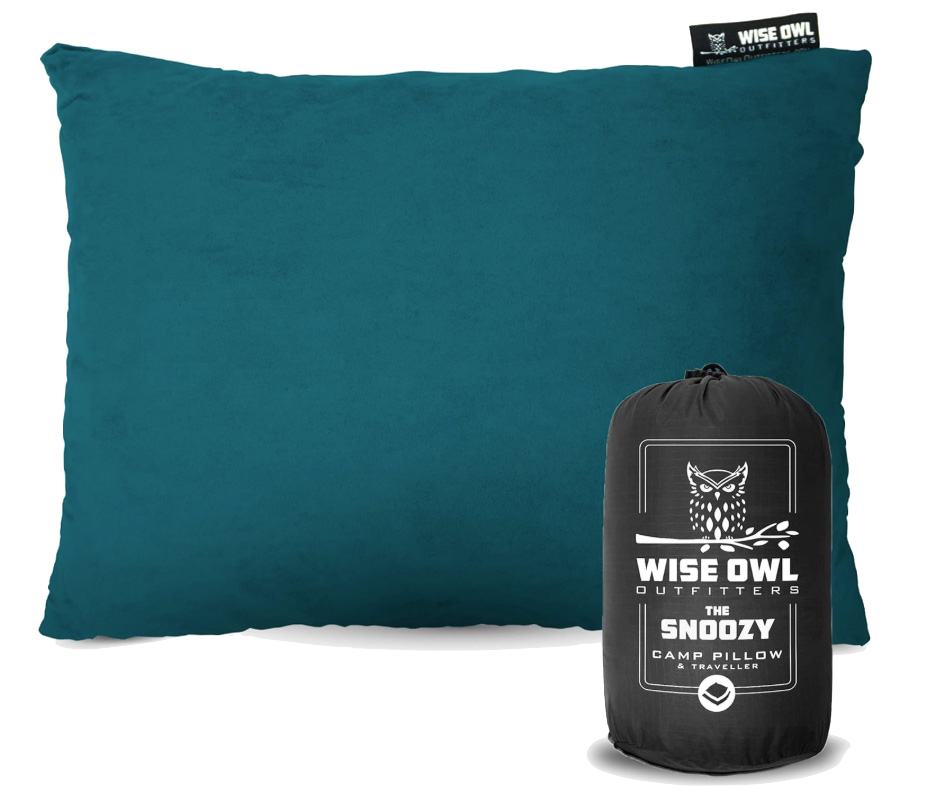 Best for: Camping
Best for: Camping
Type: Memory foam
Weight: 11.0 oz. (Medium)
Dimensions: 14 x 18 x 4 in.
What we like: A plush and supportive memory foam design for considerably less than the Hest Camp Pillow above.
What we don’t: Smaller and thinner than the Hest; too heavy and bulky for backpacking.
Hest's Camp Pillow above is our favorite memory foam design for campers who prioritize comfort above all else, but it’s no small investment at $89. Enter Wise Owl Outfitters’ Camping Pillow, which retails for less than half the price of the Hest but stacks up well in terms of all-night comfort and support. The memory foam is wrapped in a soft micro-suede cover, which feels very smooth and cozy against the skin, and it’s sold in a nice selection of bright colorways that give it the edge in styling, too. Finally, at just 11 ounces for the medium size (9 oz. for the small), the Wise Owl pillow is well over a pound lighter than the Hest and packs down noticeably smaller for stuffing in a pack or duffel bag during travel.
What pushes the Wise Owl Camping Pillow toward the bottom of our list? At 14 x 18 inches, it’s significantly smaller than the 22 x 15-inch Hest Camp Pillow. Side sleepers may also find it too thin at just 4 inches thick compared to the Hest's generous 8-inch-thick build. Again, the Wise Owl gets the clear edge for travel due to its better packability, but it’s still too heavy and bulky to bring along on backpacking trips. This tweener status puts the Wise Owl pillow in a bit of an awkward spot in our eyes. But we keep coming back to value: The Wise Owl gets you memory foam comfort at a pretty attractive price.
See the Wise Owl Outfitters Camping Pillow
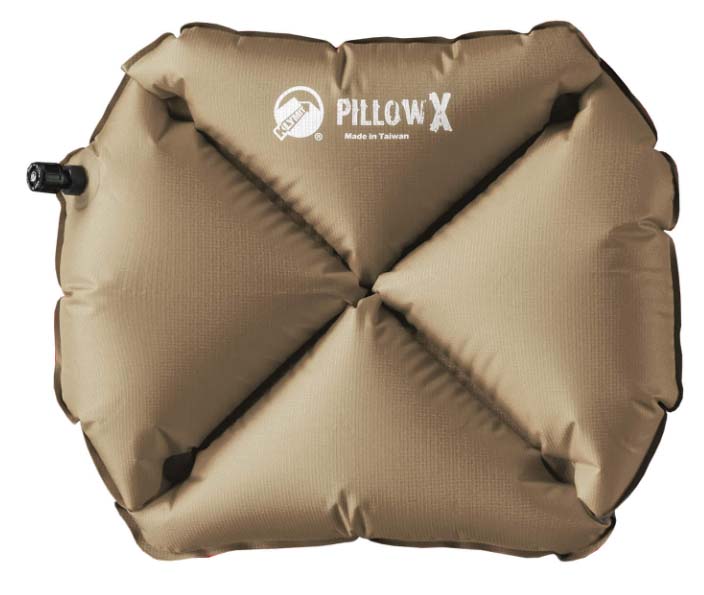 Best for: Backpacking
Best for: Backpacking
Type: Inflatable
Weight: 2.5 oz.
Dimensions: 15 x 11 x 3.5 in.
What we like: Unique X-shaped design keeps your head in place.
What we don’t: Polarizing look and feel; lacking in plushness.
A final camping pillow to have on your radar is Klymit’s aptly named Pillow X. Right away, it’s clear that Klymit went a little off-script with the design: In place of a smooth top, Klymit opted for a unique X shape that’s intended to keep your head centered throughout the night. The rest of the build is highly competitive with other leading backpacking designs, including a feathery 2.5-ounce weight, excellent packability (the pillow measures just 4.5 x 2.5 x 1 in. when compressed in its stuff sack), and a 30D polyester shell that's moderately tough (most UL competitors are 20D or thinner). Finally, at around $30, the Klymit Pillow X will save you a little cash over most of the options above.
All that said, the Klymit Pillow X's distinct shape is a love-it or hate-it feature. Additionally, the standard polyester shell lacks the plush padding and softness of most other designs here, and it’s pretty noisy and slippery, too. You can remedy these issues by bringing along a pillowcase or stuffing the pillow inside a jacket at night, but that will negate some of the pillow’s self-centering tech. In the end, the Pillow X has its place, but the lack of comfort is hard to overlook. For around $10-$20 more, most folks will be better off with a more traditional and softer design like the Sea to Summit Aeros Ultralight or Cocoon's Air-Core above. Alternatively, Klymit’s own Luxe Pillow features a plush, quilted cover and more traditional rectangular shape for $50.
See the Klymit Pillow X
| Pillow | Price | Best For | Type | Weight | Dimensions (inches) |
|---|---|---|---|---|---|
| Nemo Fillo Pillow | $45 | Camping/backpacking | Inflatable w/ foam | 9.2 oz. | 17 x 11 x 4 |
| Teton Sports Camp Pillow | $24 | Camping | Synthetic | 9.6 oz. | 18 x 12 in. |
| Sea to Summit Aeros UL | $50 | Backpacking | Inflatable | 2.1 oz. | 14.2 x 10.2 x 4.7 |
| Hest Camp Pillow | $89 | Camping | Memory foam | 2 lb. 3.2 oz. | 22 x 15 x 8 |
| Zpacks Medium-Plus Pillow | $60 | Backpacking | Stuff sack pillow | 1.6 oz. | 20 x 11.25 |
| Zenbivy Ultralight Pillow | $32 | Backpacking | Stuff sack w/ inflatable | 2.4 oz. | 14 x 10 x 3.5+ |
| S2S Aeros Premium | $55 | Backpacking | Inflatable w/ synthetic | 2.8 oz. | 13.4 x 9.4 x 4.3 |
| Exped Mega Pillow | $65 | Camping | Inflatable w/ synthetic | 6.0 oz. | 20.5 × 12.6 × 4.7 |
| Therm-a-Rest Compressible | $40 | Camping | Foam | 11.5 oz. | 18 x 13 x 6 |
| Cocoon Air-Core | $35 | Backpacking | Inflatable w/ synthetic | 3.8 oz. | 14.6 x 11 x 4 |
| Nemo Fillo Elite Wide UL | $70 | Backpacking/camping | Inflatable w/ synthetic | 4.0 oz. | 21 x 11 x 3 |
| Therm-a-Rest Air Head | $55 | Camping/backpacking | Inflatable w/ synthetic | 5.6 oz. | 15.5 x 11 x 4 |
| Sea to Summit Aeros Down | $65 | Backpacking | Inflatable w/ down | 2.5 oz. | 13.4 x 9.4 x 4.7 |
| Rumpl Stuffable Pillowcase | $29 | Camping/backpacking | Stuff sack pillow | 4.0 oz. | 17 x 12 |
| Wise Owl Camping Pillow | $40 | Camping | Memory foam | 11.0 oz. | 18 x 14 x 4 |
| Klymit Pillow X | $27 | Backpacking | Inflatable | 2.5 oz. | 15 x 11 x 3.5 |
While camping mattresses and sleeping bags get the lion’s share of attention, we always take a pillow with us when car camping and rarely leave it behind on backpacking adventures, too. These small but practical designs add a nice dose of comfort to any sleep system without incurring a major weight penalty and pack down nicely between outings. The Switchback Travel team has been testing outdoor pillows since 2022 when we started this list with 15 picks. To get the lay of the land, we took over a dozen pillows on an inaugural testing trip in Washington state, where we evaluated performance while camping along the shores of Lake Wenatchee and backpacking in the Alpine Lakes Wilderness. Our current list showcases 16 picks that range from ultralight and ultra-packable designs that disappear in a pack to cushy memory foam options for a true home-in-the-woods experience. Since the pillow market is growing and ever-changing, we’re continually updating this list with our favorite offerings.
Managing editor Sarah Nelson spearheaded this guide and leaned on other members of the Switchback team to provide feedback. An avid climber, trail runner, and backpacker, Sarah spends half the year traveling in a truck camper and understands the importance of a comfortable night’s sleep. While priorities vary depending on your intended use(s), all of the pillows on our list are quality designs built to withstand frequent outdoor use. Considerations like thickness, weight, packability, and weather resistance all come into play during testing, and we also appreciate when pillows are easy to launder between trips. Read on to learn more about the finer details and how to choose the best option for you.
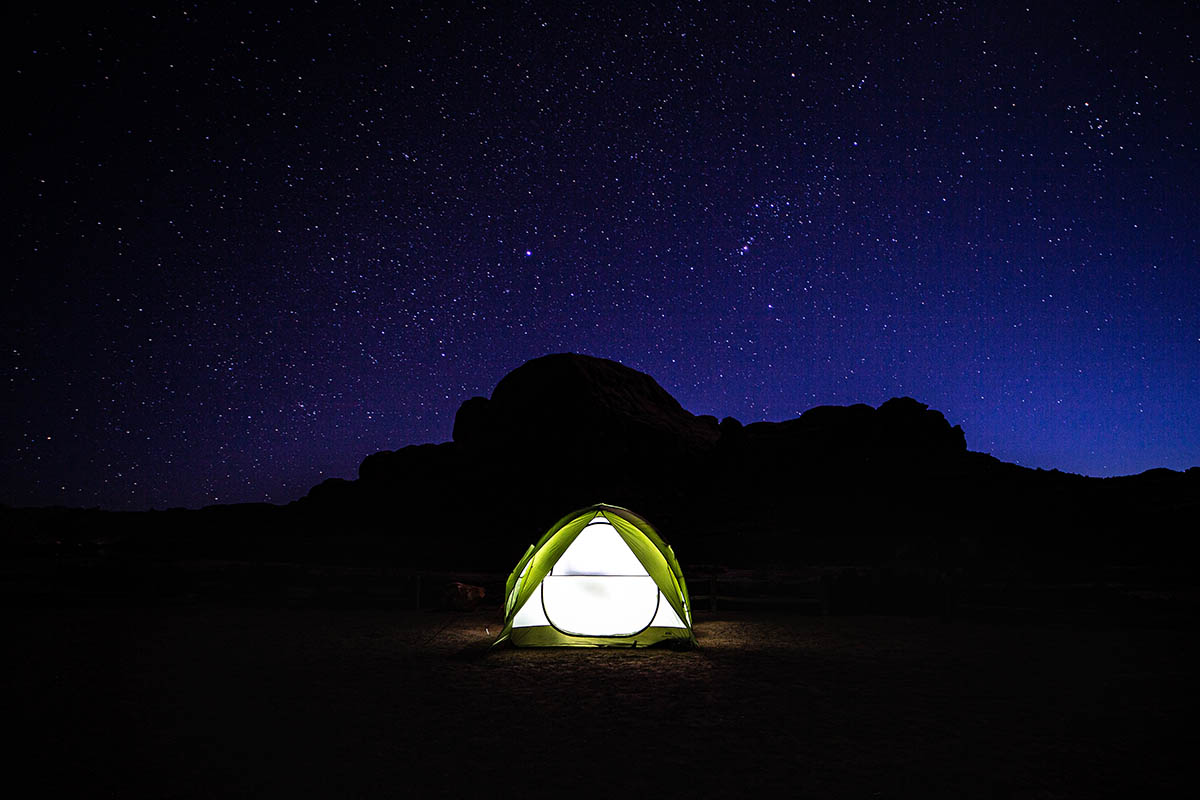
The first question to answer when choosing the right pillow for you is how and where you plan to use it most. For car camping, we prioritize comfort above all else and look for soft-touch fabrics, thick and supportive padding, and generous dimensions to maximize the amount of surface area for our head. On gear-intensive backpacking missions, we’re willing to compromise a little on all-out comfort to keep weight and bulk to a minimum and instead turn to light and compressible inflatable designs that stash easily into the crevices of our pack. There are many factors at play here, including shell thickness (which we cover in the “Durability” section below), construction type (e.g., inflatable vs. memory foam designs), and overall size and dimensions. The good news is that many of the options above cross over decently well for both disciplines, including well-rounded options like the Nemo Fillo Pillow and Therm-a-Rest Air Head.
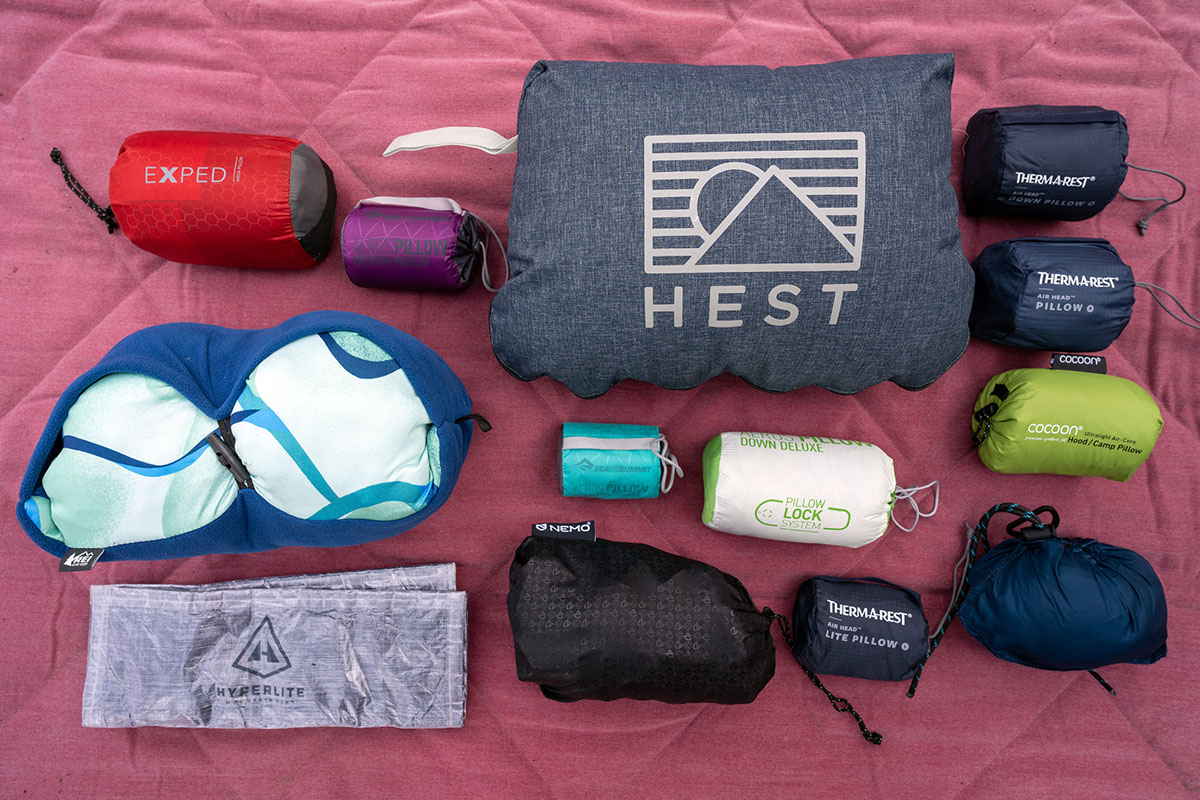
Pillow construction varies widely, from ultralight and packable inflatable designs like the Sea to Summit Aeros Ultralight to premium memory foam options with plush cushioning for ultimate camping comfort. As we cover in “Weight and Packability” below, inflatable options are typically the lightest and most compressible due to the fact that the interior is exclusively filled with air. Some inflatables, like the Sea to Summit Aeros Premium and Aeros Down, also add a light layer of synthetic or down insulation under the cover for a small boost in comfort and warmth (along with a slight weight penalty).
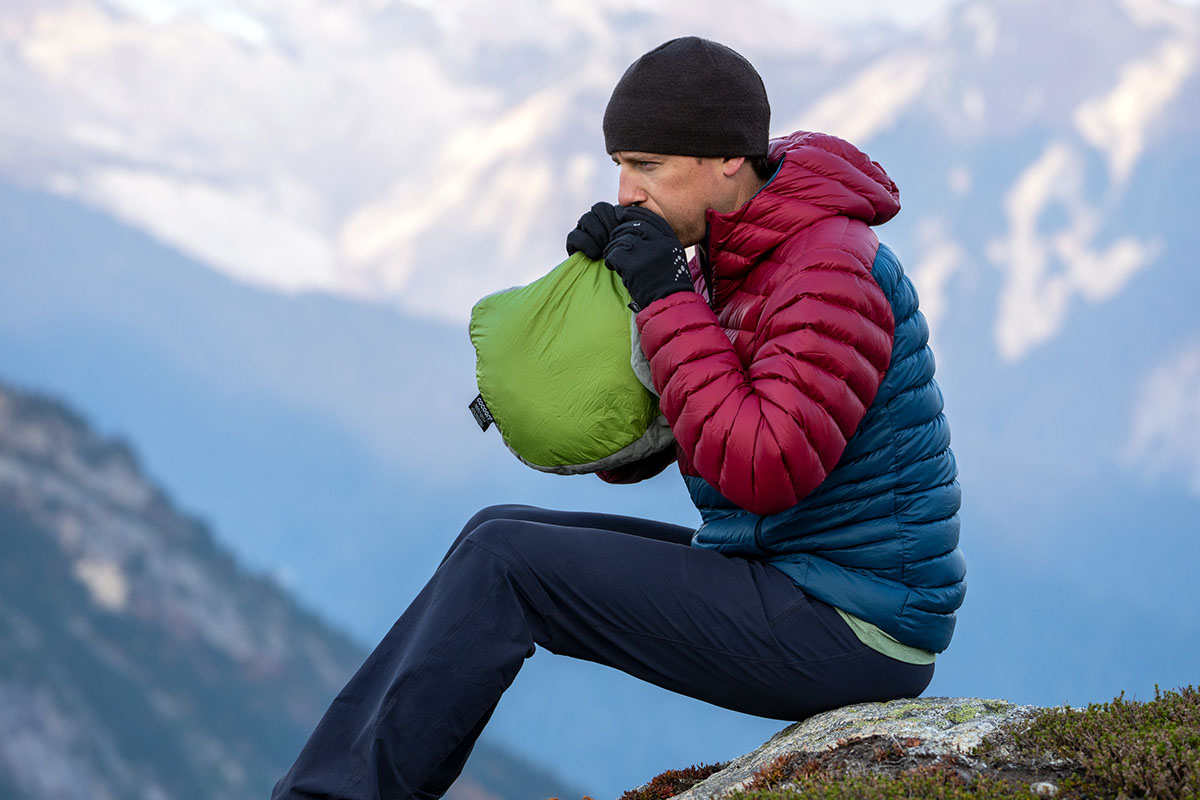
At the other end of the spectrum are non-inflatable models like the Therm-a-Rest Compressible Pillow Cinch, Hest Camp Pillow, and Wise Owl Outfitters Camping Pillow. These designs utilize foam or memory foam constructions with no air, which adds weight and bulk but comes with sizable benefits in all-around comfort and cushioning. They’re also more resistant to punctures, and you’ll still have some semblance of padding if your pillow deflates in the middle of the night. In the end, we love the premium comfort of non-inflatable foam pillows for car camping but turn to inflatable designs when we’re headed into the backcountry and want to minimize weight and bulk. Again, a final decision will come down to your sleeping preferences and intended use(s).
Stuff Sack Pillows
Stuff sack pillows are a bit of a misnomer: Essentially specialized and outdoor-ready pillowcases, these designs require stuffing clothing inside for use as a pillow. In addition to being very light and packable, stuff sack pillows like the Zpacks Medium-Plus and Rumpl Stuffable Pillowcase are also highly versatile, providing a space to stash clothing or other gear during the day. The Zpacks can also double as a dry bag to protect your clothes from moisture, thanks to its highly water-resistant Dyneema build. The Zenbivy Ultralight Pillow offers an extra dose of versatility thanks to its hybrid design that includes both an air bladder and an extra room in the oversized pillow case to add things like your down jacket to the mix for extra height and cushioning.
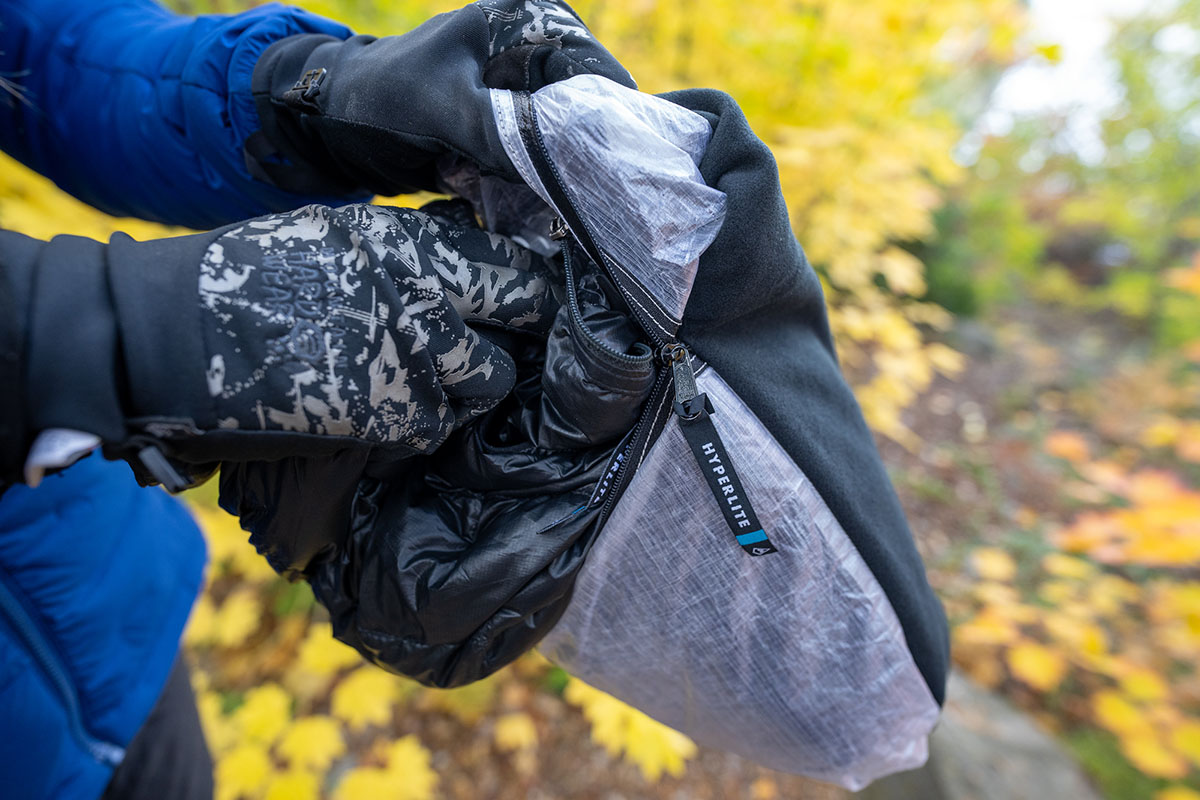
Convenience is the biggest drawback: It takes some effort and patience to achieve an even and consistent (read: lump-free) packing job—rather than just inflating your pillow, you’ll need to take time to intentionally stuff clothing inside until you reach your desired firmness. Comfort is also largely dependent on what you stuff inside (lofty down or synthetic jackets work well). In the end, stuff sack pillows aren’t for everyone, but they’re a great UL pick for minimalists and those who don’t mind putting in some extra work before hitting the hay.
Comfort is relative when sleeping on the ground, and most people who can’t handle a night under the stars don’t camp or backpack at all. That said, there’s still a wide gap between ultralight, backpacking-ready designs and car camping pillows, with the latter typically offering thicker, softer cushioning for better all-night comfort (for more weight and bulk). For instance, Therm-a-Rest’s Compressible Pillow Cinch (which is designed for camping) is 6 inches thick, and the all-foam construction offers far better support than most inflatable designs. At the other end of the spectrum is Nemo's Fillo Elite Wide Ultralight (best for backpacking), which is around 6 ounces lighter than the Therm-a-Rest but just half the thickness (3 in.). Most designs fall somewhere in the middle at around 4-5 inches thick and hit a nice sweet spot between weight and comfort.
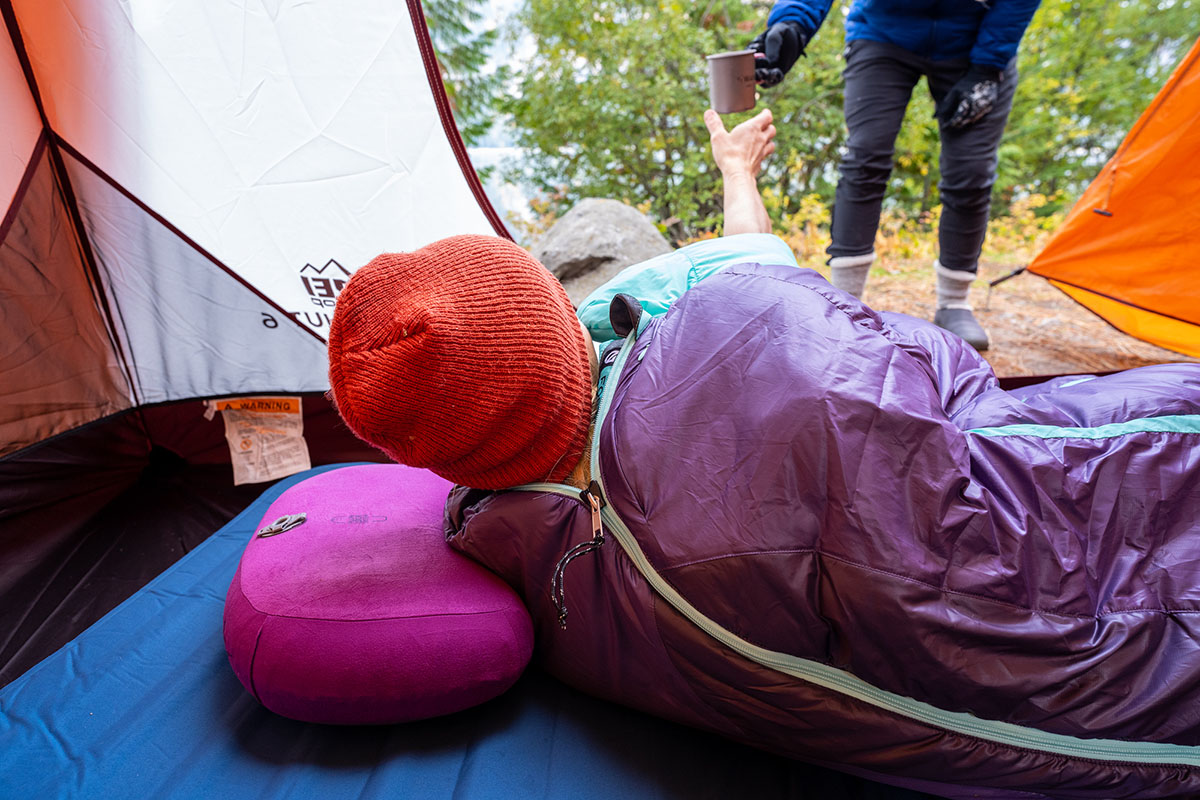
You may notice some chatter in product comments about being a back sleeper or a side sleeper. While this typically has more of an impact when selecting a sleeping pad, it can still be helpful to factor in when choosing a pillow. Height is the most important consideration: You’ll want to make sure your head is in line with your neck and spine, meaning side sleepers will likely want to upgrade to a thicker and firmer design (like the 8-in.-thick Hest Camp Pillow or 6-in.-thick Therm-a-Rest Compressible Pillow Cinch) to achieve proper alignment. Back sleepers can typically get away with less padding, but this is largely a matter of personal preference. Shape can also play a role: UL models like the Sea to Summit Aeros Ultralight are molded around the head and neck in a way that works best for us when lying on our backs (again, this can vary from person to person).
Along with thickness, a pillow’s length and width can also have a considerable impact on all-around comfort. At the larger end are camping-focused rectangular designs like the Therm-a-Rest Compressible Pillow Cinch (18 x 13 in.), Hest Camp Pillow (22 x 15 in.), and Exped Mega Pillow (20.5 x 12.6 in.), which have generous dimensions and plenty of surface area to move around throughout the night without your head falling off the pillow. On the flip side are dedicated backpacking-ready models like the Sea to Summit Aeros Premium (13.4 x 9.4 in.) and Cocoon Air-Head Hood/Camp Pillow (14.6 x 11 in.) that shave off excess material to keep weight and bulk to a minimum. As we cover below, many backpacking pillows also have curved shapes that fit nicely into the hood of a sleeping bag, which is another factor to consider if you plan to spend a lot of time in the backcountry.
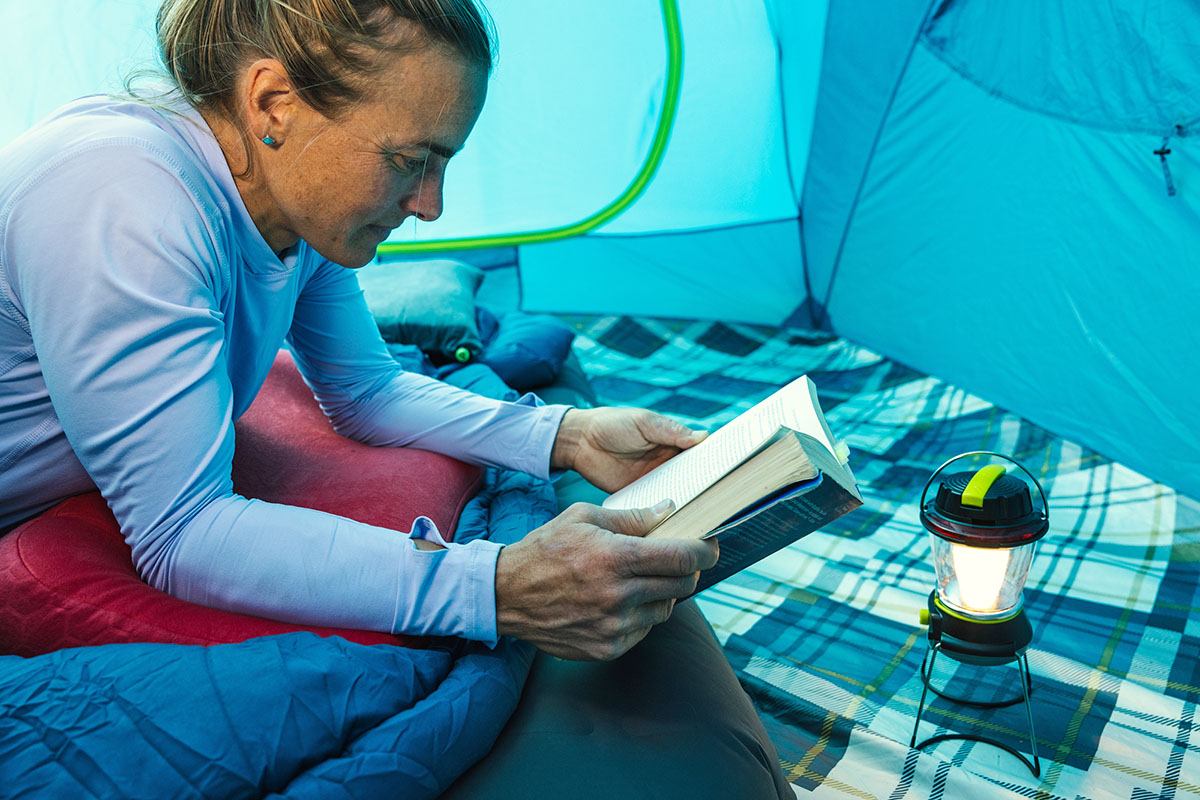
Given their small size, pillows are inherently a pretty lightweight bunch. That said, there’s a decent spread between car camping and backpacking designs, which makes sense considering that backpackers generally want to keep weight as low as possible when hauling gear on their back for miles. For comparison, the lightest option on our list is Zpacks’ Medium-Plus stuff sack pillow at a scant 1.6 ounces, followed by inflatable designs like the Sea to Summit Aeros Ultralight (2.1 oz.) and Aeros Down (2.5 oz.). At the other end of the spectrum are plush memory foam models like Hest's Camp Pillow (2 lb. 3.2 oz.) and Wise Owl Outfitters’ Camping Pillow (11 oz.). Most options fall somewhere in the middle, with the majority of the pack hovering in the 3- to 10-ounce range. Backpackers will likely want to stick toward the lighter end to minimize the amount of weight on their backs, while car campers can get away with more heft and bulk since they won’t be traveling too far from the trailhead.
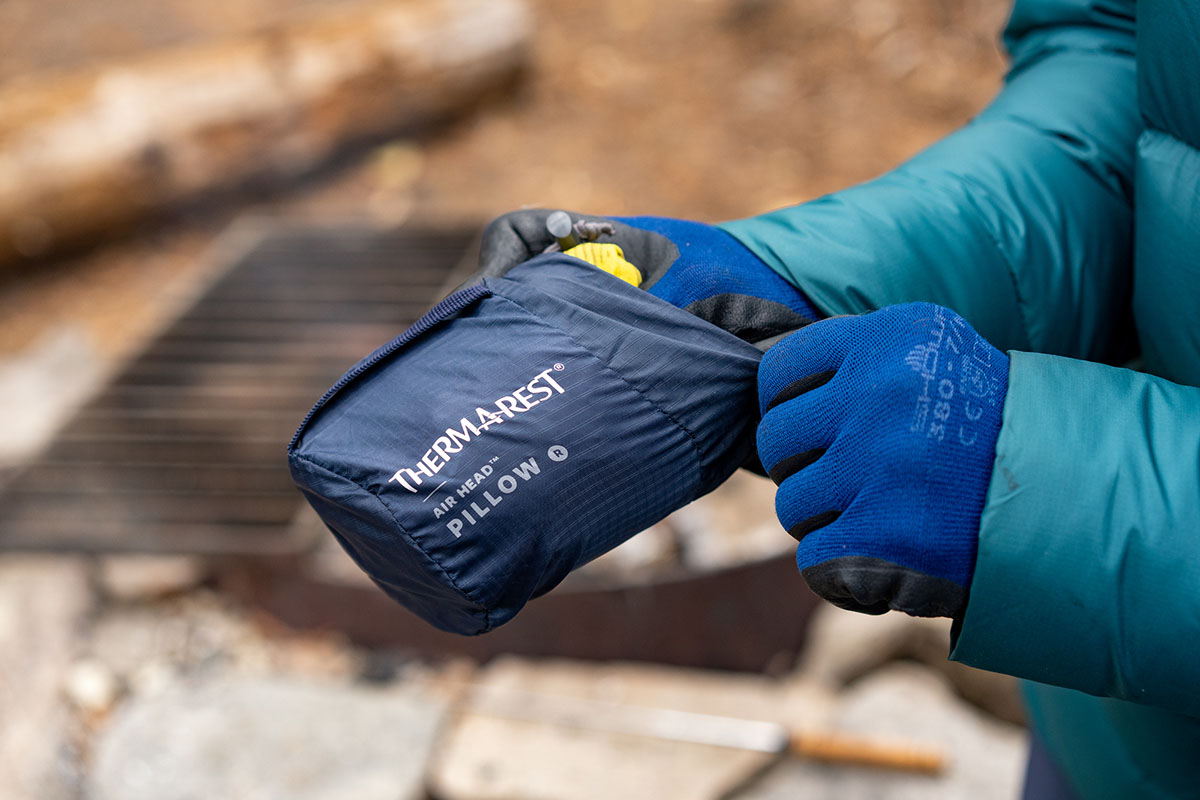
Packed size generally correlates closely with weight and is a function of the pillow type, amount of insulation, and fabric thickness. Uninsulated or lightly insulated inflatable pillows are far and away the most compact, while memory foam pillows like the Hest Camp Pillow add considerable weight and bulk —for comparison, the Hest measures 14 x 9 inches when compressed versus the Sea to Summit Aeros Ultralight at just 2 x 2.8 inches. As we mentioned above, backpackers covering long distances typically prefer lighter and more packable options that disappear into a pack, while car campers who aren’t limited on space are often willing to trade some weight and bulk for added comfort and support. And a final note: Most pillows come with separate stuff sacks that can be misplaced, while integrated designs like the Nemo Fillo and Hest Camp Pillow are less common but nice for absent-minded campers.
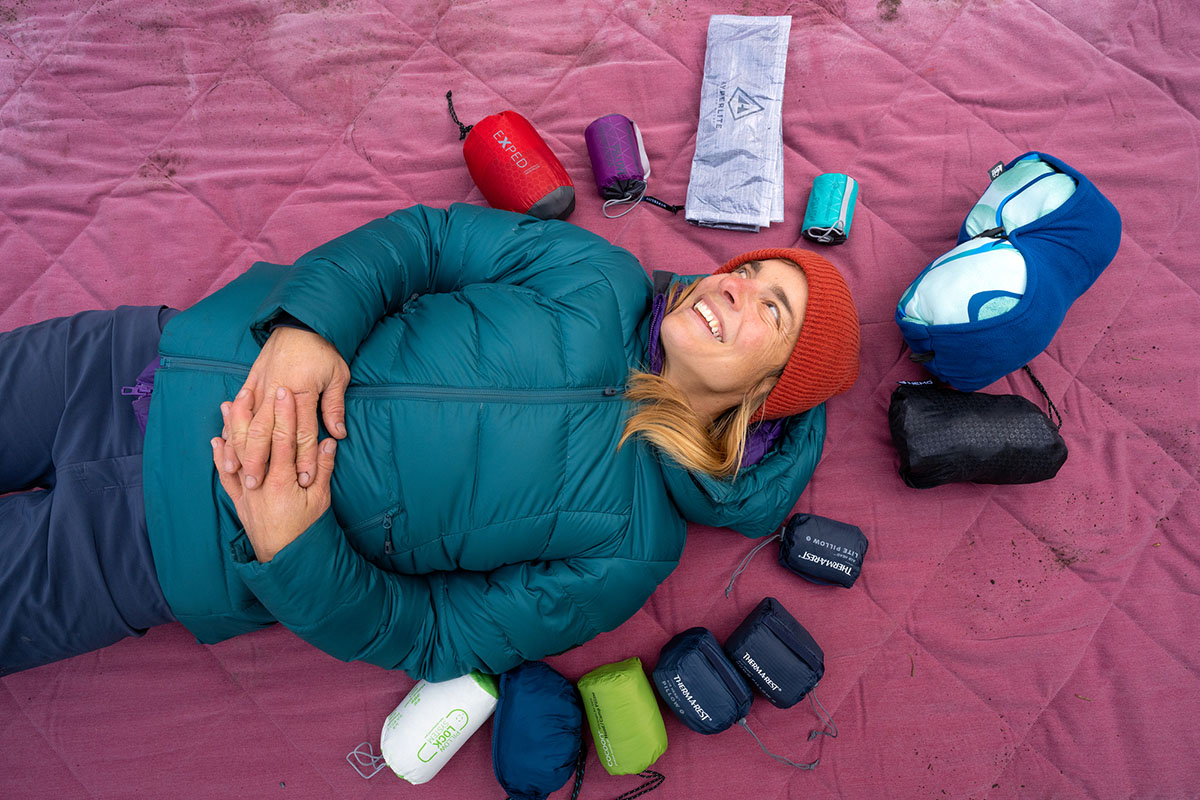
There aren’t too many variations in pillow shape, and a decision will largely come down to how and where you plan to use your pillow most. Rectangular designs like the Therm-a-Rest Compressible, Exped Mega Pillow, Hest Camp Pillow, and Nemo Fillo Elite Wide Ultralight will feel most similar to your pillow at home, with generous dimensions that maximize the amount of surface area for your head. The biggest drawback is sleeping bag compatibility: Rectangular pillows don’t fit easily into the hood of most sleeping bags, which can lead to sliding around throughout the night.
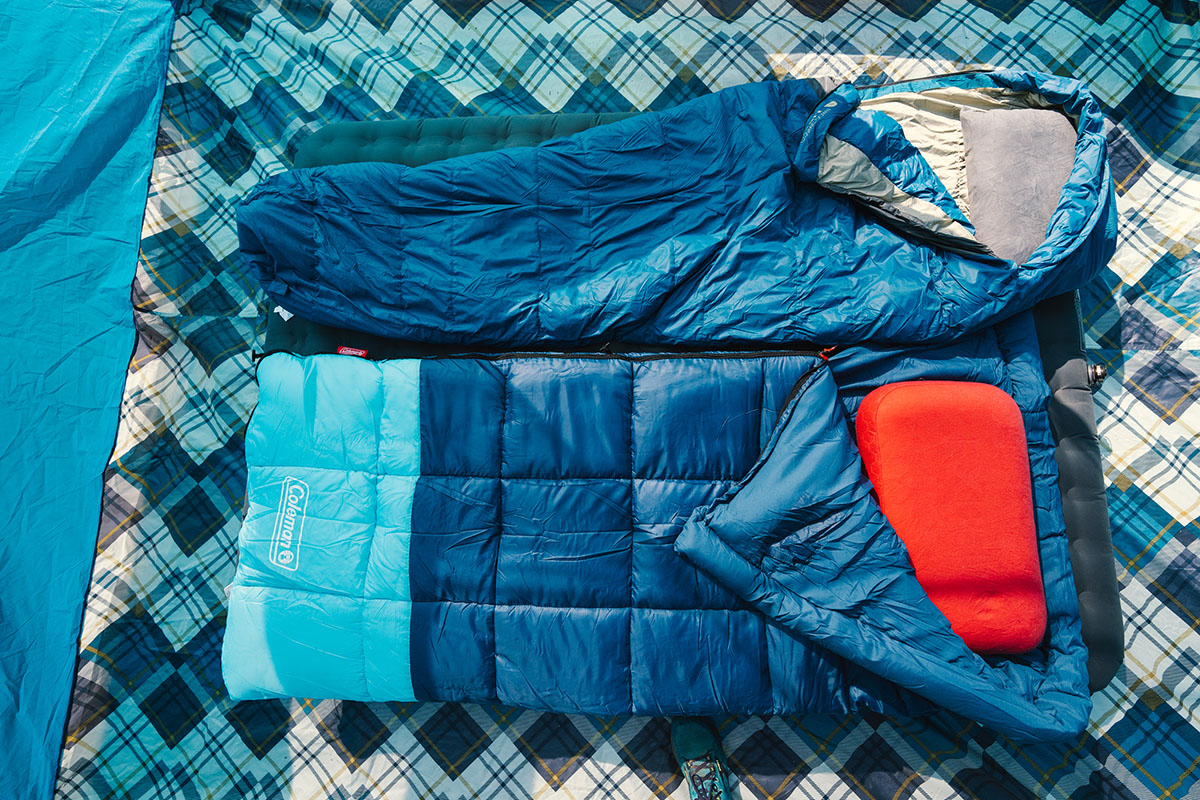
If you plan to pair your pillow inside a sleeping bag, we recommend opting for one with a curved shape (like what you get with the Sea to Summit Aeros Ultralight and Premium, Therm-a-Rest Air Head, Cocoon Air-Core Hood/Camp Pillow, and others above). While typically smaller, curved pillows are our preferred option for backpacking due to their sleeping bag-friendly shape, and the lack of material along the bottom helps keep weight and bulk to a minimum. Many campers use rectangular sleeping bags that forgo a hood, in which case a larger rectangular model could be the better bet.
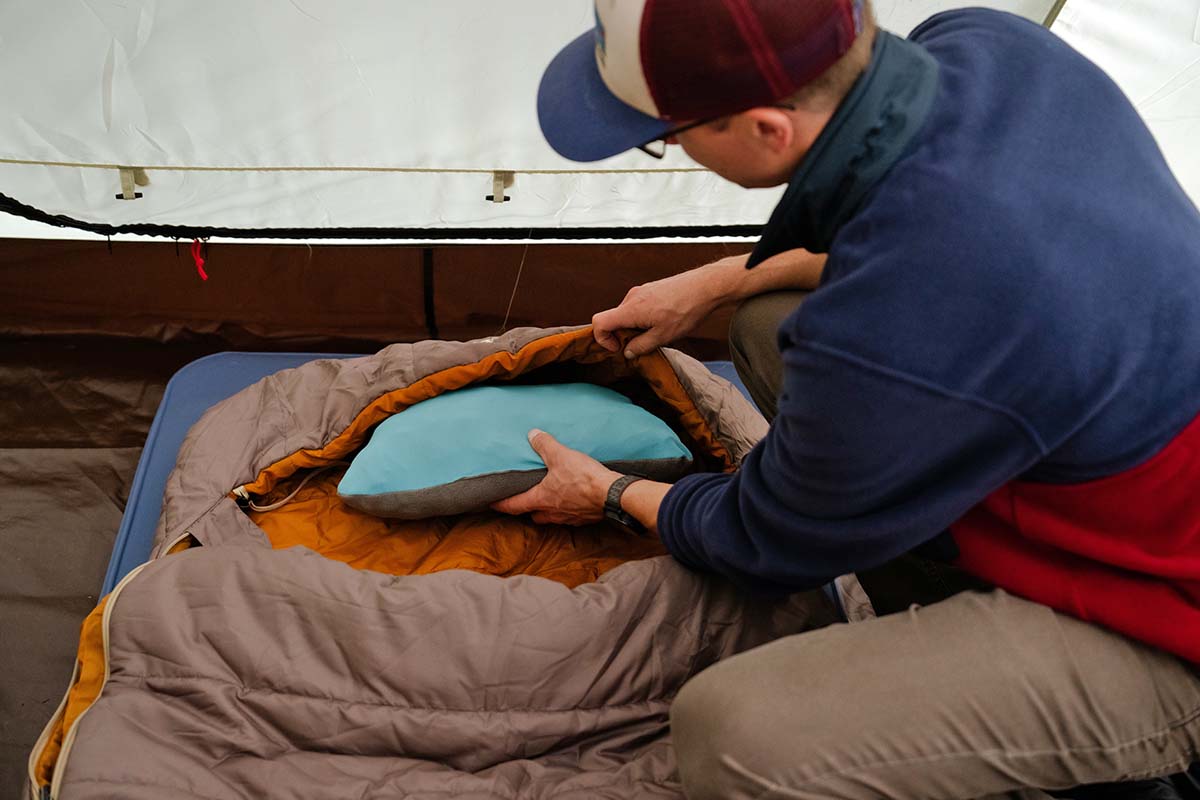
The most common measure of durability in the outdoor gear world is denier (D), which measures the thickness of a fabric. In general, lower-denier fabrics have a much shorter lifespan, a higher propensity for durability issues in the backcountry, and are typically reserved for ounce-counting backpackers who know how to take care of their gear. For example, Sea to Summit’s Aeros Down has a delicate 10D shell that’s practically see-through, while their Aeros Premium’s 50D shell is noticeably thicker and more confidence-inspiring. Most designs fall somewhere in the middle, with 20D being fairly standard in the pillow market.
It's important to note that ultralight inflatable pillows will need to be treated with the most care, as a puncture can quickly render the pillow useless (we recommend bringing along the patch kit that comes with most inflatable pillows for repairs in the field). Alternatively, all-foam pillows are the safest bet, and those that use a mix of foam and air will still offer some padding if your pillow deflates in the middle of the night.
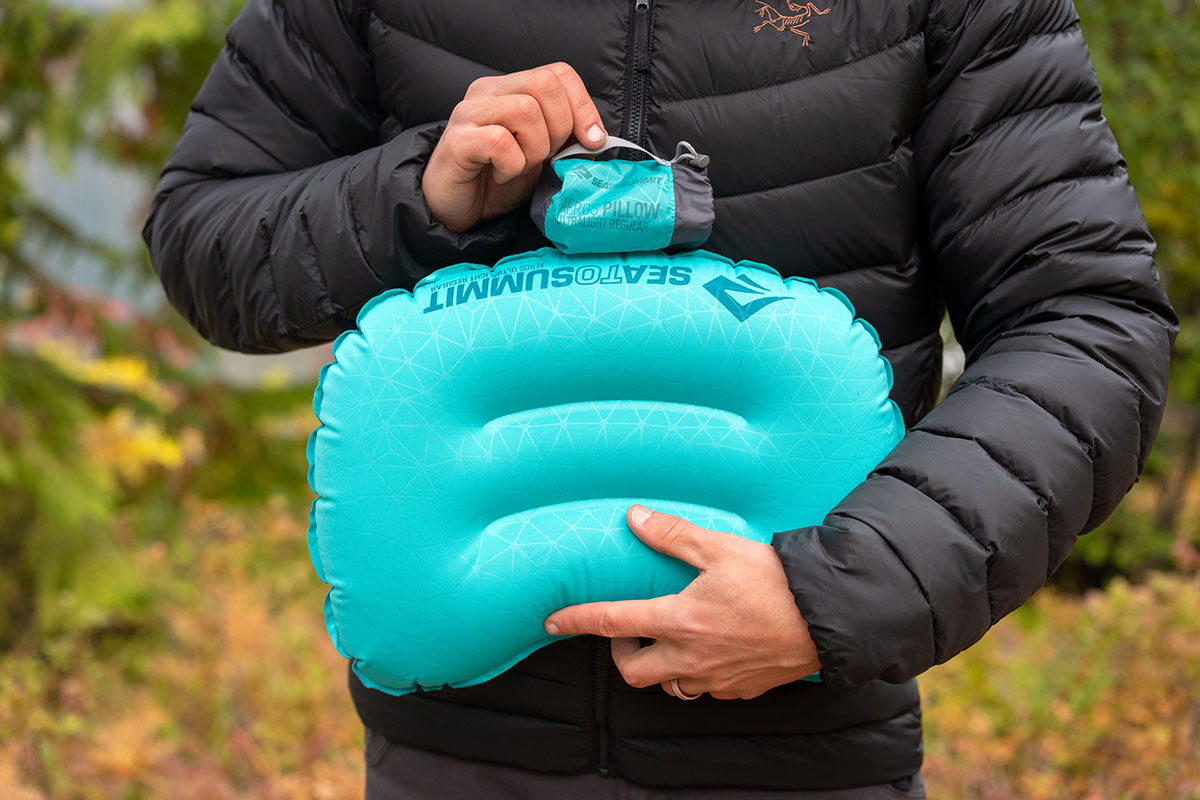
Most campers and backpackers won’t be using their pillow outside of their tent, but a little added moisture resistance can be beneficial when sitting outside by the fire or cowboy camping under the stars. Most of the designs above have a standard durable water repellent (DWR) coating that will allow light moisture to bead up and roll off the surface rather than soaking through the outer shell. Hest's Camp Pillow takes things a step further with a polyurethane (PU) coating along the nylon cover, which sheds both water and dirt. Finally, Zpacks’ Medium-Plus stuff sack pillow is the most weather-ready option here with a highly water-resistant Dyneema build, taped seams, and a waterproof zipper that allow it to double as a dry bag to protect your clothing and gear on the trail. In the end, weather resistance won’t be a critical consideration for most, but it certainly has its benefits.
All of the inflatable pillows above boast valves to add or remove excess air, which makes inflation and deflation easy and allows you to quickly tailor firmness depending on your sleeping preferences. That said, not all valves are created equal, and the difference in ease of use can be quite significant. The most basic is the traditional twist valve (as seen in Therm-a-Rest’s Air Head and Nemo's Fillo and Fillo Elite Wide Ultralight), which opens and closes by pushing or pulling a round plastic valve connected to the side of the pillow. These work pretty well in general, but there are downsides to be aware of. For one, the valve works inefficiently because it’s completely open while inflating, which allows some air to escape in between breaths. Further, their upright profile takes up space when rolled up (and pokes out while you’re sleeping), and they are slow to deflate.
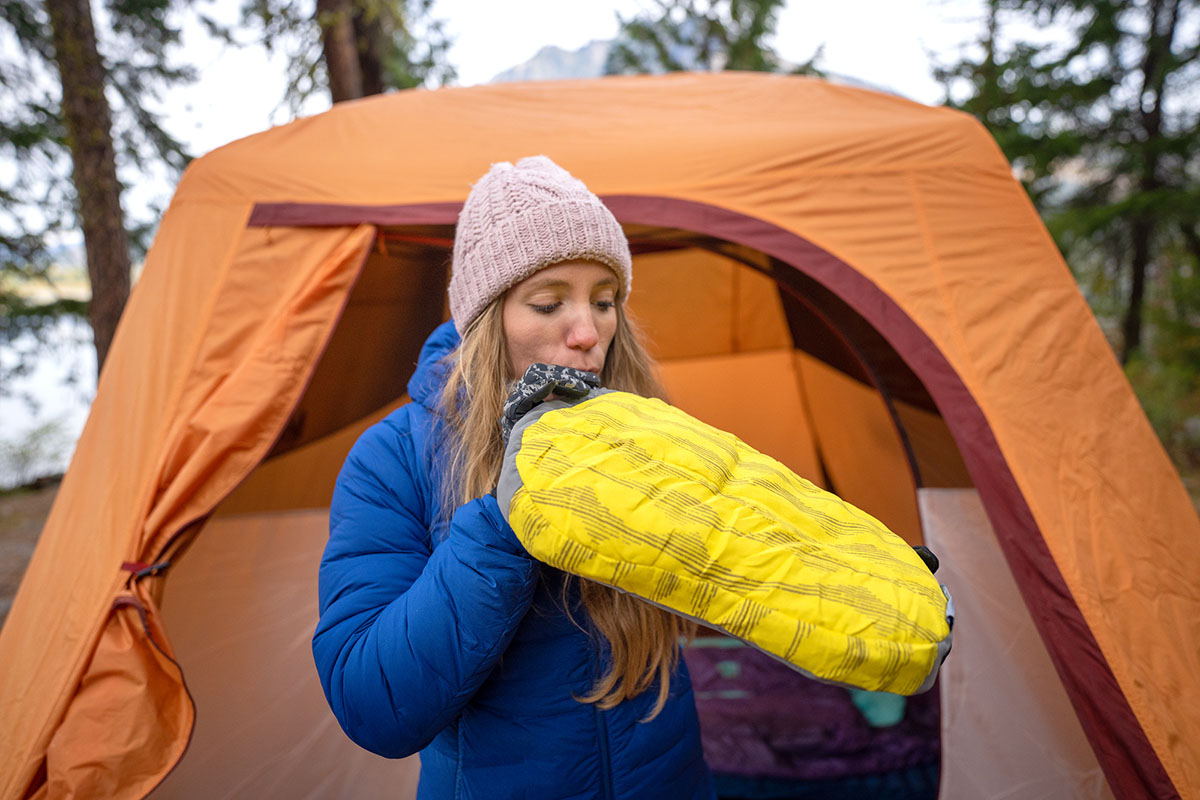
To address these issues, a number of manufacturers have turned to flat valves. Beyond the slim profile, they often have dedicated openings for inflating and deflating and, importantly, a flap that keeps air from escaping while blowing into the opening. Some of our favorite designs with intuitive and quality low-profile valves include the Exped Mega Pillow, Cocoon Air-Head Hood/Camp Pillow, and Sea to Summit’s Aeros collection, including the Aeros Ultralight, Premium, and Down models. Overall, we’ve found these designs are reliable, efficient (it takes just a few breaths to inflate, and deflation is almost instantaneous), and add essentially no weight—all excellent characteristics.
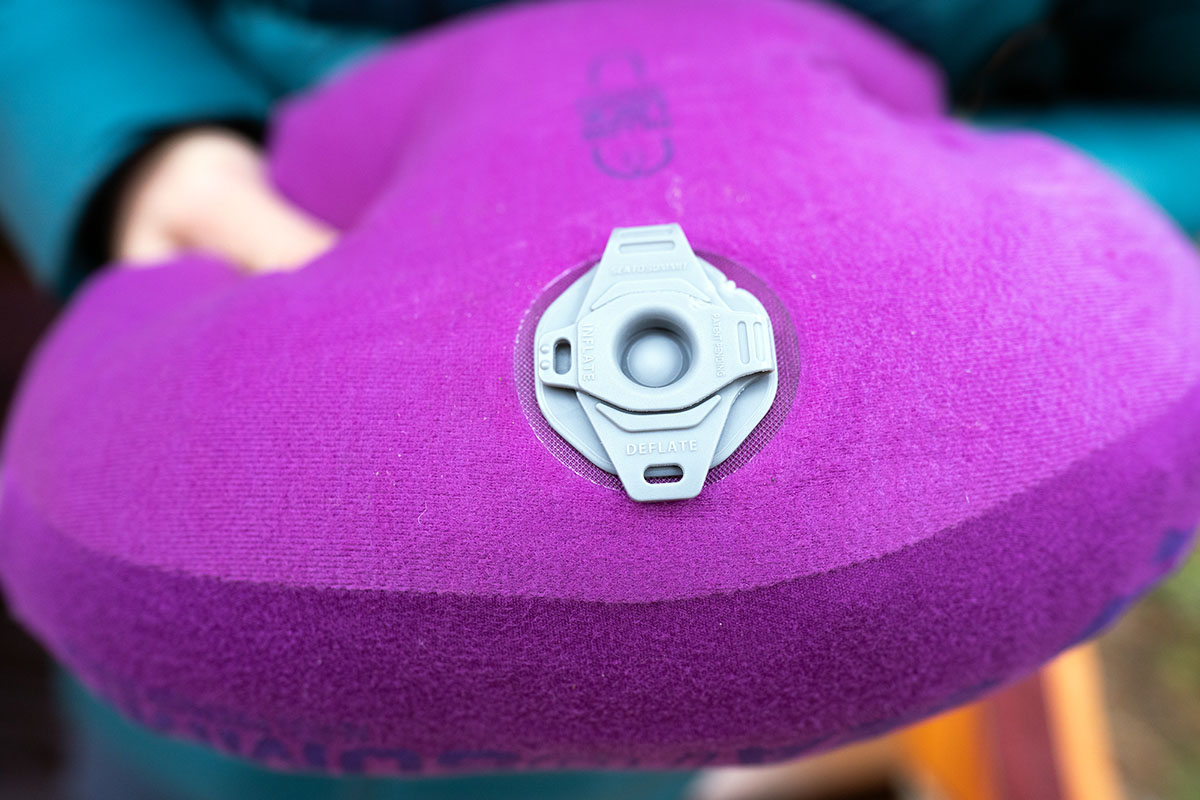
Camping and backpacking pillows are inherently basic, but there are a few helpful features worth calling out. First, we appreciate when pillows offer quick and easy cleaning solutions (more on this below). Given their tendency to slide around during the night, it’s also helpful when pillows come with attachment points to secure to your sleeping pad. Exped’s Mega Pillow is one example with thin fabric eyelets along the sides, and Zpacks also sells a Pillow Attachment Cord (a $6 add-on) to secure their Medium-Plus stuff sack pillow to your pad. Alternatively, all of Sea to Summit’s Aeros pillows boast their PillowLock tech, which attaches to any of their sleeping mats via hook-and-loop adhesive patches. A final feature worth calling out is the Cocoon Air-Core Hood/Camp Pillow’s two-sided design, which features plush polyester microfiber on one side for cold nights and smooth nylon on the other for added breathability in warm weather.
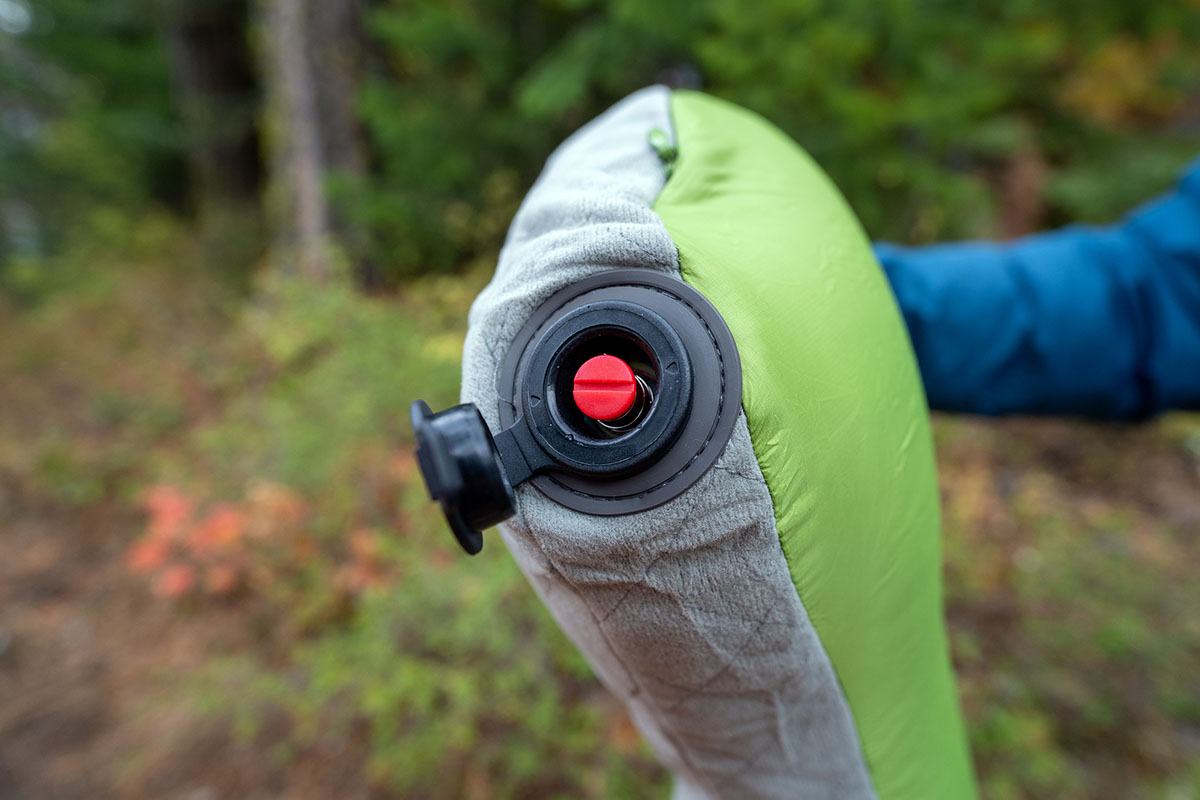
We appreciate when brands go the extra mile in creating eco-friendlier products, and one of the most common measures we see in the pillow market is the use of recycled fabrics and materials. Nemo’s Fillo Elite Wide Ultralight Pillow, for instance, uses 100% post-consumer recycled synthetic insulation, while Rumpl’s Stuffable Pillowcase features recycled fleece and a polyester shell made from recycled plastic bottles. It’s worth noting that PFAS-free DWR finishes are quickly becoming the norm in other categories (e.g., rain jackets and hardshells), and we hope to see that shift trickle down into the pillow market soon. Currently, most pillows still employ DWR finishes that contain harmful perfluorocarbons—“forever chemicals” known to have negative effects on human health and the environment.
Pillows can get dirty quickly, especially if you’re a frequent camper or backpacker who gets out multiple times each season. The good news is that many outdoor-ready pillows have removable covers that can be thrown in the wash with other clothing, including designs like the Hest Camp Pillow, Therm-a-Rest Air Head, Exped Mega Pillow, and others above. Cocoon’s Air-Core Hood/Camp Pillow also has a removable pillowcase, although Cocoon recommends hand-washing in lukewarm water and tumble drying to maximize its lifespan. .Some non-inflatable designs like Therm-a-Rest's Compressible Pillow Cinch forgo removable covers but can simply be thrown directly into the washing machine. Finally, for inflatables without removable covers, it’s best to remove all the air from the pillow and keep it rolled in its stuff sack to protect it from punctures.
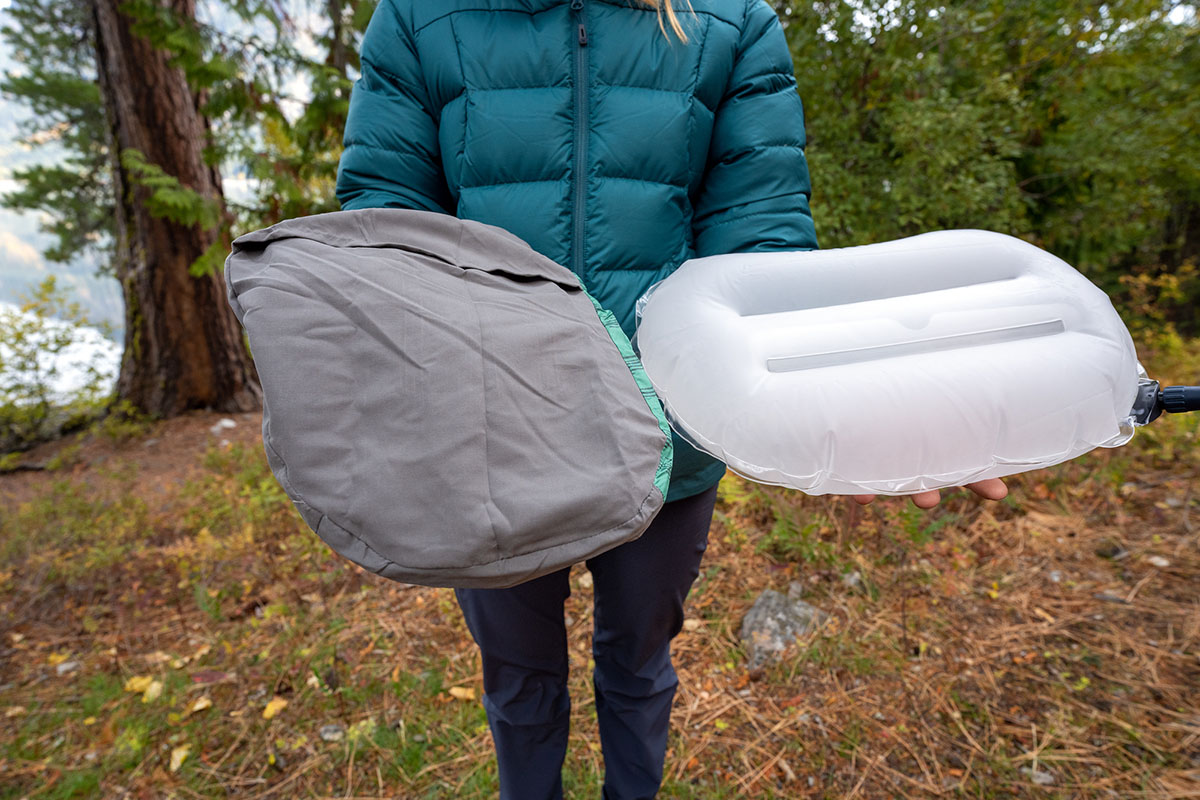
All of the pillows above are built primarily for outdoor use, but many cross over decently well for travel, too. Rumpl’s Stuffable Pillowcase is one of our favorites for this type of use, allowing you to tailor firmness and thickness by varying the types of clothing you stuff inside (e.g., baselayers for less cushioning and puffy down jackets for better loft and support). Therm-a-Rest’s Compressible Pillow Cinch is another viable option with soft and comfortable materials that compress down reasonably well for stashing in a duffel bag or pack when you reach your destination.
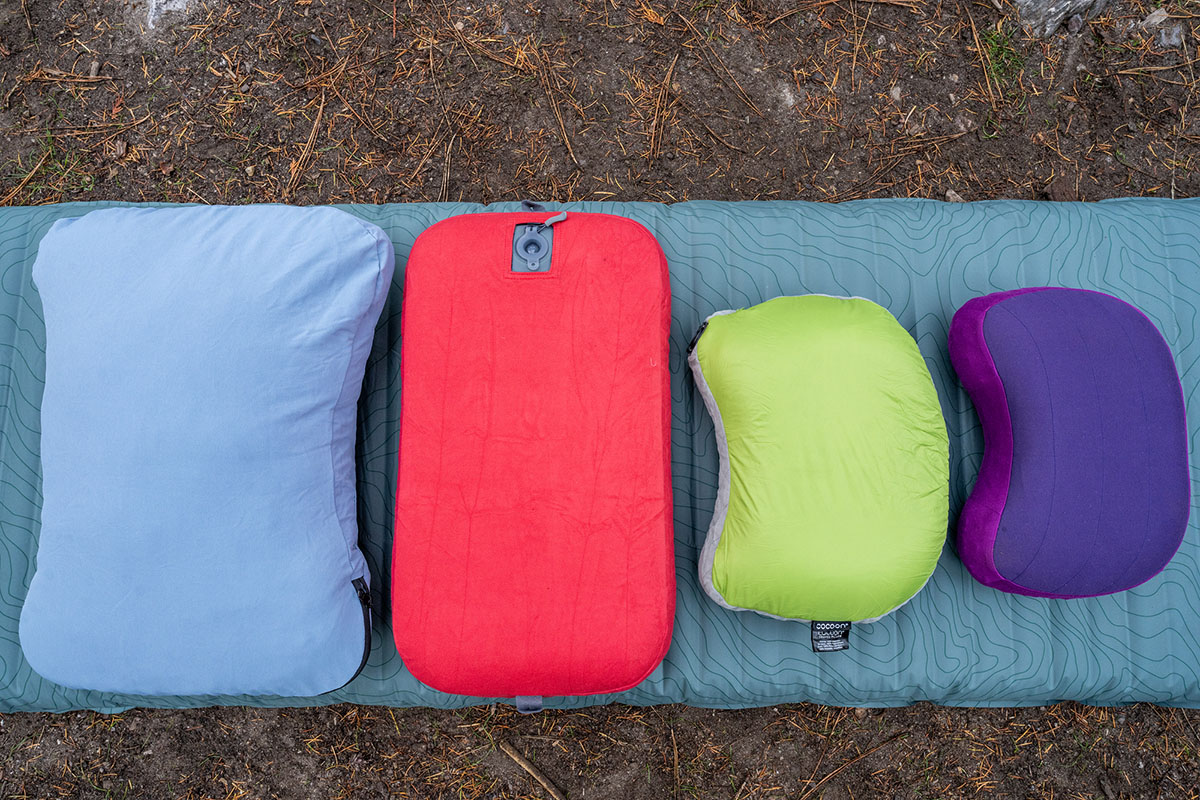
That said, frequent travelers and those who don’t plan to use their pillow outside often will likely want to opt for a dedicated travel design. Unlike the options above, these pillows typically boast U-shaped designs that curve around the neck to keep your head in place while sitting upright on a plane or bus. While typically heavier and less packable, the boost in neck support is sizable, and you often get a cinch cord at the front for securing the pillow in place while you sleep. There are plenty of affordable options available on Amazon, but many of the brands we cover above also offer dedicated designs in travel-friendly shapes. A few of our favorites are Cocoon’s U-Shaped Neck Pillow and Sea to Summit’s Aeros Premium Traveller and Ultralight Traveller pillows.
From personal experience, we went years without owning a dedicated camping/backpacking pillow and were able to make do by using a jacket or two for head support at night. Alternatively, you can always bring along a pillow from home or stuff clothing inside a cheap pillowcase while car camping (similar to stuff sack designs like the Zpacks Medium-Plus Pillow and Rumpl Stuffable Pillowcase above). That said, outdoor pillows are a pretty affordable bunch at around $25 to $50, come with specialized fabrics and features that will stand up well to long-term outdoor use, and take up minimal space when stored. The boost in all-night comfort is also noticeable enough that we no longer camp or backpack without one. In the end, only you can decide whether or not the cost is justifiable (it may come down to how frequently you sleep outside), but we feel it’s a small price to pay for a sizable bump in outright comfort and support.
Back to Our Top Pillow Picks Back to Our Pillow Comparison Table